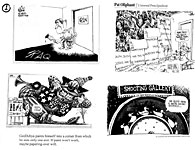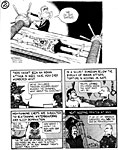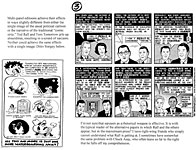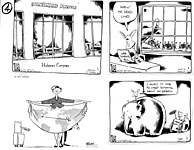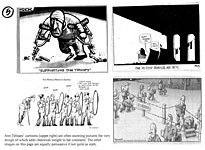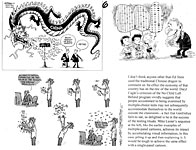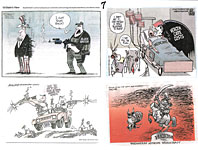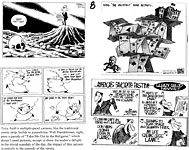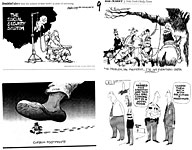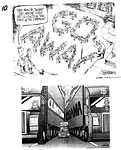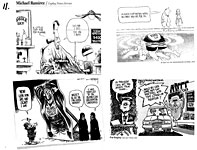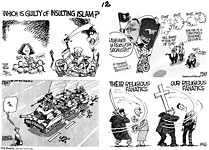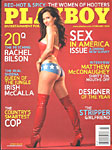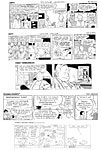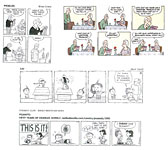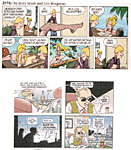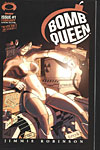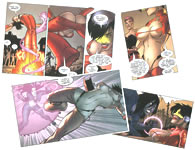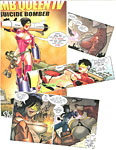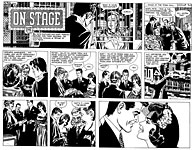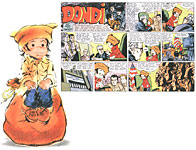 |
|||||||||||||||||
|
EDITOONERY An Gallery of Some of the Year’s Best Political Cartoons Preceded by a Diatribe about Other “Best Lists” and Time’s Lost Nose for News Including Major Events of the Year and Under-reported News from Project Censored
BOOK REVIEW The Best Editorial Cartoons of the Year: 2008 Edition from Cagle.com - What’s Wrong with It
NOUS R US Sales of Comics Continues to Increase Free Comic Book Day Date Peter Parker and Mary Jane Split Susie MacNelly Sues TMS Gus Arriola and Jean Gould O’Connell Honors
Lynn Johnston’s Double Parting Clay Bennett’s Priorities Manga in France & at Marvel 952 Caricatures in 24 Hours Michaelis’ Schulz and Peanuts New Yorker’s Cartoon-captioning Game Editor Jailed for Publishing Danish Dozen Man Fired for Posting Dilbert Strip
Playboy’s Wonder Woman Cover Irish McCalla Nude and Vintage Sheena Reprinted Writers’ Strike Effects on Comics
Marty Links Dies at 90
Birthdays in 2008 Bugs Bunny The Lone Ranger The Smurfs Oh—and Superman
THE TWO-STRIP RULE & What it Means for African-American Cartoonists & What’s Gonna Happen on February 10
COMIC STRIP WATCH Luann, Blondie, Zippy, Funky Winkerbean Pearls before Swine, Pickles, Peanuts, Zits Doonesbury, Non Sequitur
CHRISTMAS IN THE COMICS Do Newspaper Strips Celebrate It Anymore?
FUNNYBOOK FAN FARE 100 Bullets, Savage Dragon, Bomber Queen, Tank Girl, Bat Lash BOOK MARQUEE Volume 3 of Mary Perkins On Stage Dondi Another Rejection Collection from The New Yorker Mr. Oblivious
And our usual reminder: don’t forget to activate the “Bathroom Button” by clicking on the “print friendly version” so you can print off a copy of just this super-sized installment for reading later, at your leisure while enthroned. Without further adieu— EDITOONERY Some of the Best of the Year: An Aesthetic Determination Janus, the Roman god with two faces—the better to look backward and forward at the same time—gave his name to the first month of our year with good reason: we usually spend at least a few hours on the first day of the first month looking back over the events of the previous twelve with mixed feelings—head-shaking astonishment that some of them could even have happened, wild-eyed alarm that we were preoccupied with so many of the more trivial of them, not to mention such other prevailing emotions as disgust, amusement, morbid curiosity, and towering rage. We also, if we are as thoughtful as we always claim to be, ponder the future for a few minutes, hoping for a safer world, better television programming, and unrelieved happiness. And here at the Rancid Raves Intergalactic Wurlitzer, we have in recent years devoted the first Opus of the New Year to viewing some of the best examples of the art and ardor of editorial cartooning in the U.S. Editorial cartooning inevitably involves current events: if daily journalism is, as it often claims, the first, albeit rough, draft of history, editooning is the first emotional outburst at the events that provoked the first draft—unthinking sometimes, from the deepest pit of the gut always, we fervently believe. Newsweek magazine has participated in this year-end game, too, and I’ve usually criticized its editors for their empty-headed choices: in the petty tradition of their weekly Perspectives page, they always pick cartoons that make them laugh rather than think, much to the consternation of the editorial cartooning fraternity whose work the magazine deems worthy of this dubious recognition. Editoonists would rather be feared as rebellious agents of political and social change than laughed at like late-night tv talk show hosts. But their preferences matter not a whit to Newsweek, which persists in ignoring them. Or flouting them, deliberately. This year, the latter, I think. For a few years, Newsweek’s year-end issue had a political cartoon on the cover, proclaiming the summary theme of the issue. Not this year. And this year, the number of cartoons seems smaller. Their size, all about 3x3 inches, is undeniably smaller. And so is the sample: Mike Luckovich has 9 of the 12 cartoons in this issue. Luckovich is a Pulitzer- and Reuben-winning editoonist whose cartoons are often hard-hitting and unflinching, but he also likes to vary his pitches (as he puts it), throwing the occasional soft-ball Leno joke. (Most editoonists do this, knowing that humor is the hook: people enjoy laughing, and so if a cartoonist provokes a laugh every so often, he can be reasonably sure newspaper readers will read him regularly, and he can then urge his serious world-changing agenda upon them.) Since Luckovich is good at his craft, even his laugh-provoking cartoons are worthy of a second look, a circumstance profusely exemplified in this year’s Newsweek round-up. The topics are mostly trivial enough to warrant laughter: Senator Craig’s gaeity, GeeDubya’s begrudging awareness of global warming, Libby being sacrificed, Oprah campaigning for Obama, Hillary planting questions in her audiences, Thompson’s moribund campaigning style, Romney’s flip-flopping, Gore winning an Oscar, airport delays, Vick’s killing dogs, and, finally, a couple major topics although treated jocularly, the housing market and George W. (“Warlord”) Bush’s passion for invading Iran. Except for the last two, none of these “issues” rates an attack-dog cartoon, so jokes are appropriate. But in a news magazine summarizing the year’s events? This year, Time magazine, having sat on the sidelines for years, watching Newsweek get all the laughs, joined the year-end frolic, offering its pick of the year’s editoons in one of its several online “top ten” features. This selection, which can be viewed at http://www.time.com/time/specials/2007/top10/article/0,30583,1686204_1690170_1690363,00.html, is even more disastrously trivial and inconsequential than Newsweek’s crop. The cartoonists—R.J. Matson, Daryl Cagle, and Mike Peters (with two each), plus John Sherffius, Bob Englehart, Gary Clement (Canadian), and Mike Thompson—all do superior work—not a slouch among them—but Time has selected from their year’s endeavors cartoons that focus on topics that are of very little consequence. Englehart’s cartoon, for example, is about senior sex: in the first of two panels, a reporter asks an elderly couple what they think of a survey that shows senior citizens are having sex two or three times a month; in the second panel, the old guy says, “That’s all?” This is one of the Top Ten editoons of the year? Anyone even vaguely aware of the mechanisms of comedy realizes this “joke” employs one of the oldest dodges in the business; its very antiquity ought to disqualify it as a candidate for the Top Ten Editorial Cartoons. But Time’s editors are clearly clueless about comedy. The other nine topics: candidate Fred Thompson’s inability to make a good stump speech attributed to the writers’ strike, toxic toys from China, Senator Craig’s gaiety, Barry Bond’s asterisked homerun record, Iran’s Mahmoud Ahmadinejad’s visit to the U.S., Obama and Cheney related, Jerry Falwell encountering evidence of gay life in heaven, and the Virginia Tech slayings. Only the last is a very serious matter. We may conclude from this that in Time’s view, cartoons deal only with insignificant albeit funny issues and cannot, therefore, be serious journalism. But then, I don’t take Time seriously anymore either. And with good reason. Aside: I’m about to launch into a lengthy diatribe about Time’s shortcomings as a newsmagazine, with a few even more discursive detours, most of which have only a tangential relationship to cartooning. If you want to skip all the fussing and fulminating, simply scroll down a few acres until you come upon a boldfaced heading announcing Some of the Best Political Cartoons of 2007; we’ll resume our customary cartoonery commentary there. Now, let me plunge into that diatribe: At the aforementioned website, Time lists the Top Ten Under-reported Newsstories of the year, betraying a news judgement that has gone grievously kilterless: the refugee problem a-borning in Somali, six nukes inadvertently loaded onto a B-52 and flown across the U.S., the U.N.’s overestimation of the number of AIDS cases worldwide, federal agency employees illegally campaigning for Republican candidates over the past six years, drug resistant tuberculosis, the oil-nourished economic boom in Angola, obesity rate leveling off among U.S. adults, new oil fields discovered in Brazil (making it more oil rich than Saudi Arabia), earmarking legislation in Congress that continues apace despite Democrat avowals to change politics as usual, and Ethiopia and Eritrea veering towards war in East Africa. I’m not disputing altogether the seriousness of some of the issues in Time’s Top Ten list, but their magnitude, it seems to me, is dwarfed when they are compared to the first ten stories in Project Censored’s list of the Top Twenty-five Censored Stories of 2007 (published in the Project’s annual tome, Censored 2008). “Censored” is perhaps too strong a term. The stories picked by the Project are generally those that are not widely covered or deeply delved into because, as we know, corporate news media devote most of their reporting resources to stories that will increase ratings or circulation. Peter Phillips, director of Project Censored, makes the case for “censored.” In the winter issue of the Project’s newsletter, he writes: “The corporate media in the U.S. like to think of themselves as the official most accurate news reporting of the day. The New York Times motto of ‘All the News That’s Fit to Print’ is a clear example of this perspective. However with corporate media coverage that increasingly focuses on a narrow range of celebrity updates, news from ‘official’ government sources, and sensationalized crimes and disasters, the self-justification of being the most ‘fit’ is no longer valid in the U.S. ... When a media fails to cover issues [that are important to the public weal], what else can we call it but censorship?” If not “censorship,” then at least “under-reported” and legitimately comparable to stories on Time’s list. Here are the first ten of Project Censored’s current list: 1) No Habeas Corpus for “Any Person,” 2) Bush Moves Toward Martial Law, 3) U.S. Military Control of Africa’s Resources, 4) Increasingly Destructive Trade Agreements, 5) Human Traffic [i.e., Slaves] Build U.S. Embassy in Iraq, 6) Operation FALCON (Federal and Local Cops Organized Nationally) Coordinates Mass Arrests of 30,000 “Fugitives” in the U.S., 7) Behind Blackwater Inc., 8) The U.S. Invasion of India, 9) Privatization of America’s Infrastructure, and 10) Vulture Funds Threaten Poor Nation’s Debt Relief. Each of these and the rest of the Top Twenty-five are discussed in detail in the book and at projectcensored.org. But even without elaboration, most of the topics I’ve listed by their cryptic headlines seem more significant than the leveling off of the obesity rate among U.S. adults or the nukes that were inadvertently loaded onto a B-52 and flown—harmlessly, I should add—all across the country. These two stories fall into the typical categories of fevered interest among ravenous tabloid readers: the first, “news you can use” (the pressure’s off: you can now eat all you want again); the second, “be afraid, be very afraid—one of these babies could have fallen on you.” In 2000, Brooke Shelby Biggs pooh-poohed Project Censored in Mother Jones (http://www.motherjones.com/commentary/columns/2000/04/projectcensored.html), saying, among other things, that to call the stories “censored” is misleading (Phillips seems to address this concern) and that “Project Censored has become a thinly veiled excuse for an alternative press self-love fest.” And maybe she was right in 2000. But glancing over the exegeses of this year’s tally isn’t a comforting experience. As Phillips says, “The common theme of [these] stories over the past year is the systemic erosion of human rights and civil liberties in both the U.S. and the world at large” by the creation of a federal authority with powers sufficiently immune from democratic redress as to establish a virtual dictatorship. The first story in the list asserts that news media failed to take sufficient note of the provisions of the Military Commissions Act that GeeDubya signed in October 2006 which allow the suspension of habeas corpus for “any person” regardless of American citizenship. While the New York Times and others gave “false comfort that America citizens will not be the victims of measures legalized by the MCA, the law is quite clear that ‘any person’ can be targeted.” Thus, “the MCA effectively does away with habeas corpus rights for all people living in the U.S. deemed by the President to be enemy combatants.” And remember the money appropriated a few years ago to rehabilitate moth-balled military bases around the country? Looks suspiciously like someone is preparing detention camps for large numbers of “enemy combatants.” No? Then consider the John Warner Defense Act of 2007 which “allows the President to station military troops anywhere in the United States and take control of state-based National Guard units without the consent of the governor or local authorities in order to ‘suppress public disorder.’” This gives GeeDubya (or whichever Democrat replaces him next year) the muscle to enforce Presidential will. And then legislation with the seemingly harmless title The Animal Enterprise Terrorism Act (AETA) of 2006 expands the term “terrorism” to include “any acts that interfere or promote interference with the operations of animal enterprises,” which, by another expansion of definition, includes “any business that uses or sells animals or animal products.” The latter would include, for instance, grocery stores that sell beef. But “animal products” is a vast category these days, including, for example, fat, gristle, hair, bone—not to mention wool and all crops upon which “animal products” (i.e., manure) may be used—some of which finds its way into things we buy that we don’t normally think of as being derived from animals. Under this law, no one can interfere with any business where animal products might be involved. Thus, “the law essentially defines protesters, boycotters or picketers of businesses in the U.S. as terrorists.” Would a President actually use such laws to detain American citizens? In the person of George W. (“Warlord”) Bush, he already has. The sixth story in the list reports on three federally coordinated mass arrests between April 2005 and October 2006 in which more than 30,000 persons were arrested and jailed, “the largest dragnet in the nation’s history. The operations, coordinated by the Justice Department and Homeland Security, directly involved over 960 agencies (state, local, and federal) ... the first time in U.S. history that all of the domestic police agencies have been put under direct control of the federal government.” I’m being alarmist in the extreme, I suppose. But if we consider how the Bush League lawyers de-code the fine print in legislation, reading into laws intentions that no one else thought were there, my alarm may not be too wildly off the wall. Assuming, then, that I’ve put you in the proper mood, consider the Violent Radicalization and Homegrown Terrorism Prevention Act passed by the House last October. Its purpose is to study various social phenomena, chiefly those involving people with radical beliefs who might turn into people who would resort to violence, and then to propose legislation that would address and eliminate this threat before radicalized individuals turn violent. “This preemptive measure of policing thought specifically identifies the Internet as a tool of radicalization,” according to the Project Censored newsletter. Authors of the law claim that “the Internet has aided in facilitating violent radicalization, ideologically based violence, and the homegrown terrorism process in the United States by providing access to broad and constant streams of terrorist-related propaganda to U.S. citizens.” Over the years, various embryonic efforts to tax or license use of the Internet have been floated; none have yet found their way into law. “Freedom of expression” has, so far, preserved unfettered use of the Internet. But how long can that last once Homeland Security has decided that one of the best ways to protect us from “homegrown terrorists” is to charge a whopping fee for use of the Internet? That will deny radicals, who, as we all know, are usually impoverished, access to the ‘Net. Fear, one more time, will trump freedom. Well, yes—I’ve wandered far afield from simply criticizing Time’s news judgement as a way of ridiculing its choices of the “top ten” political cartoons of 2007. And I’ll eventually return to the subject with my own choices of some of the best political cartoons of the year. But before I get to that, I’ve not quite finished my ranting about Time. If evidence of Time’s news sense being drastically impaired is not sufficiently unveiled in the foregoing paragraphs, we have the magazine’s annual Person of the Year selection to cinch the case against it. Vladimir Putin. C’mon. The criteria for selecting the Person of the Year, according to Time’s website, implies that the magazine’s editors will pick the “man, woman or idea that ‘for better or worse, has most influenced events in the preceding year.’” And what signal events, exactly, did Putin influence in 2007? The events that dominated the news over the last twelve months seem to me to be these: The Surge and Iraq. Undertaken in blithe defiance of a bi-partisan report calling for actions almost exactly the opposite of this military adventure, the Surge is dramatic evidence of George W. (“Warlord”) Bush’s blinding stubbornness and of his willful disregard of all advice contrary to his “gut” feelings in the pursuit of this and all other objectives of his so-called “administration.” (GeeDubya thinks his stubbornness is heroic “resolve” and his disregard of all advice is evidence of divine inspiration.) Although the Surge may have quelled, temporarily, the violence in Iraq, the real purpose of the exercise, to permit the ruling Iraqis to achieve political stability, has fallen far short: of the 18 political benchmarks set by the U.S., Iraqis have met only 3. The Walter Reed Army Medical Center scandal, the year’s most shameful event, is but part of the whole Iraqi-Global-War-on-Terror scam; as is Afghanistan and the deteriorating situation there. And when the Blackwater private army so abused its power and privilege as to give American forces another black eye in Iraq—just what we need: a gross caricature (albeit realistic) of American military arrogance and insensitivity to the local population—it demonstrated yet again the folly of privatizing the nation’s official endeavors. Meanwhile, the U.S. continues to defend torture as a viable “interrogation technique,” thereby earning the scorn of civilized peoples everywhere, and, another disgrace, thousands go on dying in Darfur while the U.S. and the rest of the world look on in seeming helplessness, their forces and political will preoccupied in Iraq. Iran and the Bomb. The country’s inexplicable loss of nuclear capacity and its president’s shenanigans on the world stage constitute a capsule representation of the phoniness of George WMD Bush’s justification for invading the country. Economy. Home mortgage defaults due to subprime loans threaten the nation’s economy. Islamic Hooliganism. Violent protesting multitudes in the streets and suicide bombers by the score, not only in Iraq, but in Palestine, Israel, and other countries—Afghanistan, etc.—dramatize the War of the 21st Century: a war waged by the pure-in-heart have-nots against the infidel haves. Early Presidential Campaigning. The year’s non-story story. None of the so-called candidates is yet the nominee of any political party, and while the aspirants are clearly “out there” campaigning for the nomination, it’s the would-be news media that have inflated a contest for the votes of a few farmers in Iowa into an event of national significance—a contest that only pundits and intellectually impoverished newsmen could turn into a year-long expedition worthy of national news coverage. And Illegal Immigration has become the phoney issue of the phoney story for much the same reason. Groveling for votes seems to justify taking every miserable political position possible on every issue. Global Warming. At last, the Bush League seems poised to accept the idea; meanwhile, Gore gets an Oscar and the Nobel Prize. But Global Warming, like Illegal Immigration, is little more than a political diversion intended to keep the ravening press and the fickle American voter amused and distracted enough that no one will notice genuinely important matters of the public weal that, unlike Global Cooling, are capable of achievement but are willfully ignored—like the condition of the nation’s infrastructure, for instance, which could be fixed but is being deliberately side-lined. It would cost money; raising taxes would be necessary. It costs nothing to blather on about Global Warming and Illegal Immigration. Justice Perverted. U.S. Attorneys are fired for failure to adhere closely enough to the Bush League agenda; Attorney General Gonzales resigns in disgrace. And Lewis “Scooter” Libby, the Vice President’s chief minion, is convicted in the CIA leak case and then effectively pardoned by GeeDubya, all of which proves, if it needs proving, that Darth Cheney’s role in the Bush League government is more extensive than anyone could imagine. Democrats Flame Out. Nancy Pelosi becomes the first female Speaker of the House as the Democrats achieve a majority in Congress, but, apart from hooting and bloviating about the sins of the Republicans, do little more than display an unwillingness or inability to effect any change in politics as usual. As a culture, we were also afflicted with the usual Tabloid Tsunami involving such significant personages as Anna Nicole Smith, Britney Spears, Paris Hilton, Brad Pitt and Angelina Jolie, Jennifer Aniston, Barry Bonds, and Paul Wolfowitz, who, after being forced to resign from the World Bank, re-joined the Bush League as an advisor in the State Department. (Wait—what happened the last time the government took his advice?) Where, in any of this news, is Valdimir Putin? Nowhere. In selecting him as Person of the Year, Time persists in abdicating its journalistic responsibility in favor of selling magazines by pandering to what it imagines as the interests of the reading public. It did the same thing last year when it put a mirror on the cover of its Person of the Year issue and tried to persuade us that “we”—all of us, you and me and your mother-in-law—had done more to influence the events of the year than anyone else. (Well, sure; but what’s “news” about that?) In the last decade, Time has repeatedly copped out, choosing “groups” or “symbols”—Washington Whistleblowers, the American Soldier and then Bill and Melinda Gates and Bono—instead of doing the obvious, naming GeeDubya the Person of the Year. He and the neoconservatives he fronts for have clearly, “for better or worse,” done more to “influence the events” of recent years than anyone else. The fiasco they’ve wrought in Iraq has dominated the news of the world for six years, yet GeeDubya has been Person of the Year just twice during that period, getting on the cover of Time only when he gets “elected” to the Presidency, in 2000 and in 2004. Time, which inaugurated its “Man of the Year” cover story in 1927 in order to generate enough content to fill the magazine’s issue published the week between Christmas and New Year’s—a traditionally slow news period—has, since naming Charles Lindbergh the first of its holiday cover features, become so impressed with the intergalactic potency of its annual designation that it jealously protects its seeming dignity by denying the presumed “honor” to the obvious choice, that remarkably undignified international buffoon, George W. (“Whopper”) Bush. There can be no other explanation for ignoring him. Putin, who is undoubtedly a powerful Russian and who is making headlines by arranging to remain in power after the constitutionally imposed term limit expires in the spring, scarcely influenced much news in this country in 2007. Time’s editors probably settled in Putin because that would give them the opportunity to coin the headline they used in their cover story: A Tsar Is Born. In opting for a colossal pun, Time overlooked several cover story possibilities suggested by the major newsstories of the year, each of which, in the magazine’s usual practice, could serve as entre to examination of larger associated issues. The Surge in Iraq would have justified picking GeeDubya again (or, failing that, General David Petraeus) and would have permitted examination of a number of Iraq-related issues—the effectiveness of the Surge itself, the failure of the Democrats to stop the War, the Walter Reed scandal, privatizing the military, torture, Darfur, and, even, the error of accusing Iran of making the Bomb. (GeeDubya had the gargantuan gall to assert—in public where everyone could hear him—that the Intelligence report that revealed this claim to be an illusion wouldn’t change his mind on the subject, thereby demonstrating what we’ve all suspected for a long time: his mind is made up, and he won’t be confused by facts.) Other possibilities include the Iowa Farmer, represented, perhaps, by Grant Wood’s famed 1930 “American Gothic” portrait, as a way of exploring the folly of starting a Presidential campaign two years before Election Day. Quite apart from the irrationality of letting just the politically active minority in a small, demographically unrepresentative state determine the candidates of major political parties, there’s other damage being done by the Iowa extravaganza: for instance, because Iowa farmers raise corn by the acre, ethanol is discussed by vote-grubbing candidates as a viable alternative to fossil fuel when, in fact, it isn’t. Another aspect of the subject is the way primaries are arrayed across the country and the calendar. Rotating regional primaries would make more sense, be more democratic, and eliminate the dominance of such tiny populations as those of Iowa and New Hampshire. But GeeDubya and Petraeus are clearly the “persons of the year” by Time’s historic formulation. If not one of them, then Karl Rove, whose departure from the national stage might signal the end the Bush League’s kind of government by party politics, seeking always the political advantage rather than the public good, and would permit a discussion of Rove’s influence and, thereby, the idiotic policies of the neoconservative right, of which, we assume from the heavy turn-out of Democrats for the Iowa caucuses, we are, as a nation, thoroughly weary. And this might lead to an investigation of the uncommon and undemocratic (because secretive) influence of Darth Cheney, who, while proclaiming his detachment from Halliburton all the time, has realized an income of $200,000 per year from his former employer while serving as Vice President. Just how disinterested is he in Halliburton? His stock in the company, which, without having to bid competitively, has secured contracts in Iraq worth billions, has risen over 300 percent in 2006 alone. But Time has given up on such matters. As additional evidence of the magazine’s allegiance to the MTV culture of tabloid journalism rather than the somewhat more serious business of reporting governmental activities that voters should be aware of, we have the editors’ second runner-up for the Person of the Year designation—J.K. Rowling. As a former highschool teacher of English, I’m delighted that the Youth of the World, particularly in this country, have found the joys of print entertainment again. In this age of video games and the seductions of the Web, Rowling’s achievement is nearly miraculous. Profound as the influence of Harry Potter may be on the literacy of the world, he and his creator did not influence events much beyond the selling of the seventh, and last, book in the series. Time’s other runners-up, Al Gore and China’s Hu Jintao and, yes, David Petraeus, were better than Rowling and better than their final choice. But, as I’ve said, Time has effectively proclaimed its abandonment of journalistic responsibility in making such misbegotten choices as Putin or Rowling or, to lurch back to the subject that started me on this diatribe, the Top Ten political cartoons of the year.
SOME OF THE BEST POLITICAL CARTOONS OF 2007 My selection of the best editoons is grounded on the nature and function of the medium. The “best” political cartoons are those in which words and pictures blend to achieve a purpose neither words nor pictures alone without the other is capable of. That purpose for a political cartoonist may be characterized as creating an image so potent and so memorable as to influence the way people think about an issue—and, subsequently, vote about it. Advocacy journalism of the most virulent sort, deploying ridicule and scorn and, yes, laughter, the cleansing balm of the riled soul. Herein, however, I am not going to limit my choices of the “best” editoons of the year to a mere ten; nor do I think my choices are all the best there is. I don’t, in the normal course of my perambulations through the public prints, see all the work of all the good editoonists in the country. My selection may even include cartoons that are not the best efforts of the cartoonist represented. So the headline above is apt: here are “some” of the best political cartoons of the year. The cartoonists on display are (more-or-less in order): John Branch, San Antonio Express; Pat Oliphant, Universal Press Syndicate; Kevin “Kal” Kallaugher, The Economist and Cartoonists and Writers Syndicate/New York Times Syndicate (CWS/NYTS); Mike Luckovich, Atlanta Journal Constitution; Ed Stein, Rocky Mountain News; Ted Rall, Universal Press Synd.; Tom Tomorrow, ThisModernWorld.com; Siergey (sorry, I failed to pick up the whole name or syndicate, if any); Tom Toles, Washington Post; Ann Telnaes, CWS/NYTS; Steve Sack, Minneapolis Star Tribune; Jeff Danziger, CWS/NYTS; Clay Bennett, Christian Science Monitor; Daryl Cagle, MSNBC.com; Mike Lester, Rome News Tribune (Georgia); Jeff Parker, Florida Today; Mike Keefe, Denver Post; Etta Hulme, Ft. Worth Star Telegram; Thomas Boldt (TAB), CagleCartoons.com; Tony Auth, Philadelphia Inquirer; Walt Handelsman, Newsday; Bill Schorr, New York Daily News; Steve Kelley, Times-Picayune (New Orleans); Joe Heller, Green Bay Press-Gazette; Robert J. Matson, St. Louis Post-Dispatch; Michael Ramirez, Investors Business Daily; Chip Bok, Akron Beacon Journal; Dave Horsey, Seattle Post-Intelligencer; and Pat Bagley, Salt Lake Tribune.
Most of them, as sterling examples of the yoking of the verbal and the visual to create telling and often memorable images, need no further explanation. But I can’t resist commenting on a few, some of which enthusiasm appears on sundry of the twelve pages in this vicinity. But some of those pages don’t have room enough for my verbal excesses, so I’m ladling it out here, by page number; the page numbers appear along the tops of each page. On Page 4, we have three of Tom Toles’ superior blendings of words and pictures; all three create memorable messages which, absent pictures, are impossible of achieving as economically otherwise. Ann Telnaes’ visual comment is similarly superb: GeeDubya, who has lied and dissembled so often that he is no longer believable even when commiserating about human tragedy, has started sending his wife out to voice American concern about the brutal crackdown in Burma, for instance, and elsewhere. Telnaes’ caricatures are always dead-on, too. On Page 9, we have one of the most unusual deployments of a political cartoon at the upper left. The Denver Post has lately taken to re-printing “archival” cartoons by Mike Keefe. This one from 1995, a powerful image in itself, gains more power as we realize it’s still pertinent after more than a dozen years: it demonstrates as nothing but a vintage image can how shamefully Congress has been dilly-dallying instead of fixing a system that is increasingly reliant upon syphoning off the financial resources of the younger generation. Steve Kelley’s cartoon (lower right) needs the pictures only to identify the speakers and their presumed attitudes; the power of Kelley’s message resides mostly in the agility of the verbal content. At the upper left of Page 11, Michael Ramirez’s message can be conveyed in no other way than this clever diagrammatic melding of words and pictures. Chip Bok’s image at the upper right is an inspired way of pointing out that Fred Thompson, coming into the campaign so late, made an ass out of himself. The juxtaposition of images in Pat Bagley’s cartoon at the lower right is a telling comparison of John F. Kennedy and Mitt Romney on the issue of religion in government: Kennedy, all sober oratory; Romney, a drive-in pandering to fast-food lovers with what we might term “McPolitics”—give ’em what they want. The next page, our 12th, is all Bagley. As I’ve mentioned before recently, Bagley has for years been flying below the national radar in political cartooning because he hasn’t been syndicated. When Cagle Cartoons started distributing Bagley’s work, he was suddenly visible in several venues—national news magazines and other newspapers. His work is powerful, his command of the medium masterful, delivering telling image after telling image. Although I think the quality of his work warrants the kind of attention it’s getting here with a whole page devoted to his cartoons, the page is also justified by reason of his recent emergence on the national editooning horizon. And that’s some of the best of the year.
BOOK REVIEW Before we drift too far out to sea and away from landlubber editorial cartooning, here’s another annual round-up, from Daryl Cagle’s political cartoon website, cagle.com, edited by Cagle, a “liberal” (more-or-less) and Brian Fairrington (a so-called conservative), The Best Political Cartoons of the Year: 2008 Edition (288 8x10-inch pages in black-and-white; paperback, $16.99), a misnomer of a title since its contents are culled from 2007's cartoonery, not 2008's. But you knew that. I’m not going to take up much of your time with this review: I’ve reported on this book every year for as many years as it’s been published, and my observations remain substantially the same. Lots of cartoons (over 800 of them) by lots of cartoonists (162) makes this volume worth putting on the shelf for purely historical reasons. The flaws in the collection include: too many cartoons printed too small, too much emphasis on trivial matters, and too many cartoons by one of the editors, Cagle, with 31 (his nearest competitor, Mike Lester, has only 19; and after that the numbers hover around a dozen for the most represented cartooners), and the overweening presence of cartoonists in Cagle’s syndicate, Cagle Cartoons, which leads one to suppose that the book is as much a promotional brochure as it is a serious compendium of the year’s events as seen by cartoonists. But there are many many other cartoonists, non-Caglers, in the book, so it’s not quite fair to say it’s merely an excuse to promote the cartoonists syndicated by Cagle Cartoons. As for Cagle focusing so rambunctiously on himself, he reported last November that he was surprised by a pile of statistics he’s been assembling to discern which of the cartoonists on his site is the most popular. And he actually blushed (he sez) to announce that he, Daryl Cagle, was at the top of the list. The rest of the top ten, in rank order, were: Pat Bagley, Eric Allie, Monte Wolverton, Matt Bors, Andy Singer, Brian Fairrington, Shannon Wheeler, Clay Bennett, and Jen Sorensen. If some of these names are not much bruted about in your household, it’s probably because several of them appear only in alternative papers or only on Cagle’s site. Cagle found other matters of interest in the list: looking at the cartoonists ranked second, third and fourth, he notes that Bagley and Wolverton are “Bush bashers who are strongly against the war in Iraq” while Allie “is a loyal Bushie and supporter of the war in Iraq.” The list includes 5 liberal alternative cartooners, an arch conservative, and “two non-alties on the left,” Cagle says. “The only trend I see,” he concludes, “is that these artists are mostly liberal, with very strong individual styles and points of view. I shouldn’t be surprised that they have loyal fans.” Ditto Cagle himself: he is good at what he does. By way of ascertaining the persistent triviality of the publication’s content, you may arrive at a snap judgement by comparing the number of pages devoted to the Don Imus brouhaha with the number commenting on the housing market crash: 14 vs. 12. Are these two occurrences actually of equal importance? The “Crazy Diaper Astronaut” who drove from Houston, Texas, to Orlando, Florida, to attack her astronaut boyfriend’s new girlfriend—wearing a diaper so she wouldn’t have to stop en route and loose any time peeing—also got 12 pages. Other sections ridicule “Kramer’s” racism, “bewildering Britney,” Harry Potter, Vick’s dog fighting career, Paris in prison, Senator Craig in the toilet (12 pages) and Anna Nicole Smith. There are only four pages each on the resignations of Rove, Gonzales, and Rumsfeld; ditto on the scandal at Walter Reed Medical Center and the collapse of the bridge in Minnesota. Saddam’s death by hanging rates 12 pages, the whole Iraq disaster only 30, shabby treatment by comparison. Take another look at my list of major events of the year again; you won’t see many of them taking a lot of pages in this collection. My criticism is that if this book is a showcase for political cartooning, it spotlights mostly whatever events can be easily turned into comedy. One could conclude, then, that editoonists are out only for laughs and have no serious journalistic or societal intentions at all. That too many readers of newspapers see political cartoonists in precisely this way is a complaint among most of the fraternity. This book perpetuates and fosters the misbegotten view that cartoonists are mere pen-wielding pranksters. This year, Cagle explains more carefully than in previous years why “we have so many cartoons about the lovesick-diaper-astronaut compared to Iraq.” It’s “because that’s what cartoonists really drew this year.” Unlike the only other annual compilation of this genre of cartooning, Pelican’s The Best Political Cartoons of the Year, edited, usually, by Charles Brooks, Cagle and Fairrington don’t ask the cartoonists to submit the cartoons that the cartoonists think are their best. The cartoonists, if left to their own devices, would pick only what they regard as their most “important” cartoons, so Cagle and Fairrington would get “lots of cartoons about Iraq, President Bush, and civil rights, and not the cartoons drawn about celebrities and popular culture”—not the cartoons that were ridiculing inconsequential events of the year. But Cagle and Fairrington do the selecting for this volume, and they choose from what the “cartoonists really drew in 2007, in the correct proportions.” Cagle claims the book is a history book. True: it’s the history of political cartooning in a given year—not the history of societies or nations or governments or global warming or of events that changed the course of human affairs. And if we take this book as an indication of the role of political cartooning in 2007, we must say that editoonists mostly aspire to be Jay Leno. Despite what they say in moments of high journalistic ambition, they’re aiming for laughs, not political clout. They’re cartoonists, after all, not historians or philosophers or political scientists. And so we get 20 pages about the hilarious antics of presidential candidates during a year that they should have been attending to government instead of cultivating Iowa farmers. The gamboling of politicians makes for some good jokes, no question. And maybe, now that I ponder it, that’s the serious thinking we’re supposed to do: maybe Cagle and company intend that we think of candidates for our nation’s highest political office as comedians. I confess, I often do just that. Not that all the cartoons in this book are on trivial subjects, drawn with the sole object of inciting laughter. Some are hard-charging, thought-fomenting cartoons. And I could easily have picked a couple dozen to include among my own harvest of “some of the best of the year.” But most, by far, just make us giggle, not think. Many, however, show impressive skill in deploying words and images for effect. Talent, in the editooning brotherhood, is not wanting.
NOUS R US All the News That Gives Us Fits The “No. 1" comics-related newsstory of 2007 was, according to Captain Comics (aka Andrew A. Smith at captaincomics.us), the continued growth in sales, which, as of the end of November, was estimated at $394.02 million, “closing in on last year’s $395.55 million.” Over-all at Diamond [Comics Distributors Inc], “sales have climbed every year since 2000, when they were in the $255-275 million range.” The Captain’s other “Top 5 Comics Stories of 2007" include: comics invasion of the Web, burgeoning reprint books of comic book features, “Spider-Man 3" being the No. 1 box-office movie of the year with $336,530,303 in ticket sales, and a cluster of “content” improvements—Marvel’s “Civil War” series, concluding with the death of Captain America and inspiring at rival DC another long series, “52"; Marvel’s comic book version of Stephen King’s Dark Tower novels; and the realistic-look make-over at Betty and Veronica. Last spring’s four issues of the Betty and Veronica Digest in which their new look debuted will be published as a graphic novel, just to prolong Archie’s studied attempt to crash the new market that the manga invasion fostered. ... Free Comic Book Day in 2008 will be Saturday, May 3, just on the cusp of the annual Cartoon Appreciation Week sponsored by the National Cartoonists Society. Peter Parker and his wife of twenty years, Mary Jane, have dissolved their marriage because of irreconcilable differences. My guess is that the colossal Spider-Man movies represent the irreconcilable part: Peter Parker isn’t married in the movies, but he is in the comic books and newspaper strip. So how do Mom and Dad explain this difficulty to their 8-year old children, masquerading as teenagers and college students when they buy the comics? To preserve the assumed integrity of the Spidey movie universe, it was necessary to eliminate this conspicuous difference. The Marvel moguls, however, will sing a different song. Said editor-in-chief Joe Quesada: “A single Spidey is truer to the spirit of the character.” Probably—if you retain in your memory his angst-ridden adolescence, the basis for the character’s uniqueness when he was first formulated by Stan Lee and Steve Ditko. “There’s a certain amount of stability that comes with being married,” Quesada told Dareh Gregorian at the New York Post. “Once he does become stable [i.e., married], you take away some of the drama that was a crucial part of his life.” I agree. But Quesada didn’t want to divorce the couple or make the web-slinger a widower because, Gregorian wrote, “that would make one of their company’s biggest icons seem too old.” The solution, I must say, is ingenuity at its apogee. Peter’s ailing Aunt May is near death, and the faustian Mephisto comes along and promises to restore her to health if Peter agrees to let him wipe out all memory of his being married to Mary Jane. She, presumably, is also brain washed of all such recollections. So is just about everyone else. No one, now, “including his beloved aunt, remembers that Peter Parker is Spider-Man” despite his having revealed his secret identity to the world during the notorious Civil War series last year. Mary Jane and Peter remember having dated and having been engaged, but they’re presently “on the outs.” We’re back at Square Two. Aaron McGruder is taking another step towards realizing his lifelong dream of becoming a Hollywood power: he’s “made a deal to develop a live-action series for the online hub Super Deluxe” (Editor & Publisher). “McGruder, whose high-profile comic strip was distributed by Universal Press syndicate 1999-2006, said he’s looking forward to doing topical commentary without the long lag of animation,” which is his current Boondocks gig in the Adult Swim on the Cartoon Network. ... The Olympian, “serving South Puget Sound” in Washington, joins the list of papers that are considering dropping B.C. and The Wizard of Id “because creator Johnny Hart died.”... Meanwhile, Susie MacNelly, widow of Shoe comic strip creator Jeff MacNelly, filed a lawsuit in November against the Tribune Media Services, charging that TMS is obstructing her plan to move the strip to King Features. TMS maintains that their contract, which expires on March 31, contains a first-refusal rights clause that enables it to extend the contract provided, as Alan Gardner points out at dailycartoonist.com, it matches any offer from another syndicate. “TMS has met King Features’ offer of $350,000,” Gardner writes, “and thereby feels it has fulfilled its contract and can extend” the original agreement with MacNelly. MacNelly, however, thinks beyond the purely monetary to ancillary possibilities, such as sales and licensing “that TMS is not providing or is incapable of providing,” and upon that basis is bringing suit. ... Gus Arriola, whose Gordo comic strip was the longest running (1941-1985) comic strip with a Mexican milieu and one of the most artistically rendered strips of all time, was honored January 19 with a Lifetime Achievement Award from the Arts Council of Monterey County in California, where Gus lives with his wife Frances. There’s a great photo of Gus at http://championsofthearts.org/Arts2008.html ; and more, taken from my stash (accumulated for the biography I wrote about him) at http://championsofthearts.org/GusPhotos.html. And there’s more about Gus in the book itself, which is described here. ... From Jeffrey M. Kersten, secretary of the Chester Gould-Dick Tracy Museum in Woodstock, Illinois: Jean Gould O’Connell’s biography of her cartoonist father has been nominated by the Mystery Writer’s of America for its 2008 Edgar Award in the category of Best Critical/Biographical Work. O’Connell is the principal founder of the Museum, housed in the Old Courthouse on Woodstock Square, said Kersten, adding: “The pride we feel here at the Museum is enormous.” Her book, which we described here in Opus 216, can be ordered through the Read Between the Lynes Bookstore in Woodstock by phoning 815/206-5967. ***** It was rumored, for a while (started by Karen Lindell at venturacountystar.com), that Lynn Johnston would actually retire from working on her celebrated comic strip, For Better or For Worse, next September. At present, the strip mixes reruns of older sequences of daily gags with installments carrying a current, 2007-2008 storyline. The rumor was that in September, the current, or “new,” material would cease and FBOFW would consist entirely of vintage material from its early years. The McGuffin was that Michael, the oldest of the Patterson offspring, married and with children of his own, would reminisce about his childhood, thereby “explaining” the older material. That’s still the plan, but Johnston won’t be giving up work on the strip altogether as it was rumored, briefly, that she would. Instead, she’ll be reworking some of the art in the older strips before they’re rerun (dailycartoonist.com). This will eliminate some of the difficulty she and her syndicate, not to mention editors of the newspapers running the strip, were having: people complained that the vintage strips looked as if they’d been drawn by some hack. Johnston’s style evolved over the years, and her current 2008 style looks much different from her older, “looser” style. That difference will, presumably, be eliminated or subdued under the new plan. Henceforth, beginning next September, all the strips published will be in the “looser” style. By then, she intends to wind up all the present yarns in the strip, gathering up the loose ends into a tidy ball. April and Anthony will somehow arrive at a future together—or not; and the stroke-ridden grandfather, Jim, will probably die. Even spending some time re-touching old artwork for the vintage reruns, Johnston will have more time on her hands than she has presently. She says she’s contacted single ladies she’s been friends with for years, and they’re planning travel and other divertissements. Unlike Ellie and John Patterson, the comic strip couple, Lynn and Rod, the cartoonist’s husband of 31 years, separated last April and intend to divorce. “He met someone else,” she told Pam Becker at the Chicago Tribune. “Well—it’s a surprise.” After a bit, she added: “Rod and I had some wonderful adventures together. If it hadn’t been for him, I wouldn’t have gone up to northern Manitoba, I wouldn’t have learned how to fly an airplane [Rod is a pilot], I wouldn’t have learned how to drive a combine and a tractor, I wouldn’t have learned Spanish. I wouldn’t have done nearly the things that I’ve done. Who knows what I would have done?” ***** Searching for a successor to editoonist Clay Bennett, The Christian Science Monitor has narrowed the field of possibilities to about a dozen, according to Clayton Jones, the paper’s editor of commentary pages. “There are a lot of good ones out there,” he told E&P. Having their own editorial cartoonist is important, Jones said, because “it’s another voice on the opinion page that’s done in a different format than text—and it draws high reader interest.” Bennett left the Monitor after ten years to join the Chattanooga Times Free Press as of January 1, replacing Bud Plante, who left Tennessee paper for the Tulsa World, which has been without a staff political cartoonist since the death last year of Doug Marlette. Bennett left the Boston-based paper because, he said, he wanted to do cartoons on local issues as well as the national and international matters that are the Monitor’s focus, and he wanted to move back South; his previous staff position had been in Florida at the St. Petersburg Times, where he had been unceremoniously fired, ostensibly for budget reasons but probably, as it developed over the years, because he didn’t share the same political views as a newly arrived editor. Interviewed by Ayumi Fukuda at businesstn.com, Bennett said the “top three priorities” for him in considering a cartooning job are “editorial freedom, job security, and quality of life. The way I see it,” he continued, “the Chattanooga Times Free Press is three for three. My highest priority, of course, would be editorial freedom. The conversations I’ve had with my old pal Bud Plante about his experiences in Chattanooga, along with my discussions on the topic with the newspaper’s publisher, Tom Griscom, convinced me that this job would offer the kind of latitude that I desire. Editorial freedom is a huge issue for any cartoonist, and a major factor in the quality of any cartooning job.” The University of Iowa now has an online digital collection of the political cartoons of one of the genre’s pacesetting practitioners, Jay “Ding” Darling of the Des Moines Register (dates of his life here). Ding was one of the first editoonists to be syndicated. Drawing nearly one cartoon a day from 1900 until he retired in 1949, he produced, he once estimated, 15,000 cartoons. The Special Collections of the UI Libraries has scanned about 6,000 of the original drawings, “along with proof sheets and microfilms,” reports Matt Kelley of Radio Iowa News. ... Mike Riga at the Brandeis Hoot (thehoot.net) lists the following as his five favorite (perhaps his notion of “the best”) movie adaptations of comic books: “Constantine” is fifth; then “Sin City,” “Hellboy,” “Road to Perdition,” and, ranking first, “Batman Begins.” Riga’s criterion, apparently, is faithfulness to the original four-color incarnation. If you want to play this game, you might begin with a copy of Film & TV Adaptations of Comics: 2007 Edition, a 149-page book by ComicsDC blogger Michael Rhode and Manfred Vogel, that lists thousands of adaptations in the U.S. and worldwide (E&P); for more about it, visit lulu.com. Manga have arrived in France, reports Takashi Morioka at nichibeitimes.com. French translations of manga have been produced for about 20 years, but recently, stores specializing in the Japanese genre have opened for business, which, apparently, has been brisk. Meanwhile, at the New York Anime Festival, December 7-9, the buzz, reported PW Comics Week’s Heidi MacDonald, was about the announcement that Marvel and Del Rey’s manga arm will hook up to produce manga interpretations of the X-men franchise. Aiming directly at the huge manga audience in this country, the first X-men title will appear in the spring of 2009; starring Kitty Pryde, the only girl in an all-boy mutant school, the X-men will be “re-imagined in a shojo (girl’s) manga version. The second title will be a shonen (boy’s) version of Wolverine.” The other excitement at the Fest, if we are to judge from another PW Comics Week report by Kai-Ming Cha, Brigid Alverson, Ed Chavez and Laura Hudson, was “bumping shoulders with waves of girls in super frilly dresses—‘gothic lolitas’—and all manner of anime fans in costume and out. The Anime Network’s maid café, where ‘waitresses’ dressed up in maid outfits (actually, adorably energetic teens, delighted to pose and dance for the cameras) greeted customers with a bow and attracted hordes of equally adorable dancing and enthusiastic teenage co-players.” The manga sex fantasy come to life, sounds like to me. John Lustig’s Last Kiss comic strip, which converts terribly serious old romance comic book art into contemporary comedy with new speech balloons speeches by Lustig, was among the casualties at the Seattle Times when the paper laid off 17 staffers in the circulation department, stopped publishing a Sunday tabloid news section for regional residents, consolidated weekday and Sunday features, and, starting in 2009, reduced the newspaper’s width by an inch to save newsprint. Lustig’s fans rained e-mail on the paper, to no avail. Last Kiss can be seen in the monthly Comics Buyer’s Guide. ... Howard Huge is back in Parade magazine; the issues of December 30 and January 6 carried the Bunny Hoest-John Reiner feature, which has been a stalwart in the weekly for several generations. ... Prince Valiant, launched in 1937, passed its 3,700th mark on January 6, 2008. ... USA Weekend is now posting its first online comic strip: by the magazine’s Creative Manager, Casey Shaw, Thurbear is a somewhat rumpled-looking version of a Care Bear (rumpled in attitude, too: he calls himself “The Couldn’t Care Less Bear”). The strip, often a single strip-wide panel, is posted weekly on Thursdays at USAWeekend.com; click on “cartoon.” ... In Singapore last month, a cartoonist “who goes by the name Peter Draw,” drew 952 caricatures, working non-stop (drinking only water but not taking so much as a toilet break) for 24 hours in a public park to raise money for Habitat for Humanity Singapore. Instead of paying Peter, his victims donated money to the cause, altogether more than $8,000 Singapore dollars, about $1,000 more than was needed to build a home, saith Margaret Perry at channelnewsasia.com. **** David Michaelis’s penultimate draft of his controversial biography, Schulz and Peanuts, was 1,800 single-spaced typewritten pages long. A two-volume opus being out of the question, he pruned the text to 900 pages—partly by excising every non-essential word or phrase, partly by pulling out whole storylines. Among the casualties, I suspect, was an examination of how Schulz’s second wife, now his widow Jeannie, appeared in the strip. Schulz’s first wife was pretty clearly reflected in the bossy Lucy; Jeannie, however, apparently inspired Charlie Brown’s gentle little sister, Sally. Michaelis’s cuts short-changed the last 20 or so years of Schulz’s life: fewer than 100 of the volume’s 566 narrative pages are devoted to Sparky’s second marriage and his subsequent career. That abbreviation accounts for some of the Schulz family’s objections to the book, but they have others, focused on factual inaccuracies and on what they regard as a skewed portrait of the cartoonist. ... Wiley Miller devoted the Non Sequitur releases of October 30-November 3 to ridiculing Michaelis’s apparent strategy in the book. In this sequence, the little girl Danae takes notes for a biography she plans to write about her father if he ever becomes “a beloved public figure,” transforming the commonplaces of his life into tragic or uncomplimentary terms. When her father deftly catches a housefly in mid-flight, exclaiming, “Gotcha! Ha! I’ve still got it—king of the fly snatchers!”, Danae jots down: “He had a lifelong penchant for killing small creatures.” I’m not sure I’d go quite that far, but Michaelis has given Wiley plenty of grounds for precisely this kind of satire. My 9,000-word review of the book and reviews by several others, including a critique by Schulz’s oldest son, Monte, will appear in a forthcoming issue of The Comics Journal. The originals of Wiley’s satirical sequence he has donated to the Charles M. Schulz Museum in Santa Rosa, California. The Reserve Bank of India is producing comic books to teach customers “financial literacy,” according to timesofindia.indiatimes.com. So far, two titles of the series are published in 13 languages, aiming at “children, and semi-urban and rural folk.” RBI plans five more titles, each focusing on different aspects of personal banking and financial management. ... Several universities have launched courses teaching how to make comics, among them: University of Cincinnati, U. Of Alaska - Fairbanks, Savannah College of Art and Design. Lisa Cornwell at AP reports that Ben Towle, director of the National Association of Comic Art Educators, says it’s too soon to have hard data on numbers or where new classes are being taught, but the Association is fielding many more inquires about starting classes. The cause of this a-borning burgeoning is, undoubtedly, the emergence of the graphic novel as a culturally respectable literary form. Gee, I didn’t know there was a “National” Association of Comic Art Educators. How many of them can there be? How many is an association’s worth? Good news, though, no matter how many (or few). ... A new game, available at Target and Barnes & Noble for $25, is based on The New Yorker’s back-page cartoon-captioning contest. The game version of the exercise requires each of 3-6 players to devise in 45 seconds a caption for a captionless cartoon dealt from a deck of cartoon cards; the dice roller picks his or her favorite and then tries to identify which player wrote it. At the Houston Chronicle, the reviewer liked the “creative calisthenics” for the brain but thought 45 seconds was a bit too short a time to concoct New Yorker-style comedy. A sample cartoon shows a giant cat eyeballing a mouse hungrily. One of the players wrote: “You wouldn’t happen to be that cartoon cat who eats only lasagna, would you?” Aleksandr Sdvizhkov, once deputy editor of the now defunct Belarus weekly newspaper Zgoda, was sentenced to three years in prison for “inciting religious hatred” by publishing eight of the Danish Dozen in February 2006 (pajamasmedia.com); other editors who have been brought to trial in various countries for the same offense were fined but none, as far as I know, have done time. It’s likely that Sdvizhkov’s jailing was motivated by political concerns other than the strictly religious. For one thing, the offending issue of the paper never reached any readers: upper management stopped distribution before it got to any vendors in Minsk. For another, Zgoda was shut down two days before the presidential election; “the cartoon affair was seen as a pretext for taking action against a news outlet covering the candidate” opposed to dictator Aleksandr Lukashenko. ... Cartoonists in many other countries often lead harrowing lives for expressing their opinions. But in Africa, they have been enjoying somewhat greater freedom to express themselves these days than of yore, according to a 1997 report at WACC Global’s website by Gado, a Tanzanian cartoonist. (Yeh: I know it’s an old report, but I believe it still sheds light on the dark continent.) In 1988, editoonist Janathan Zapiro had to go into hiding, fearing for his life, after cartooning against the apartheid regime of the day. But with the growth of multi-party politics in most African countries during the 1990s, freedom of the press has emerged, and cartoonists began to feel less intimidated. The satraps of government in some countries, however, still often behave in dictatorial fashion, so while cartoonists feel freer, they are still somewhat wary. Freedom of expression isn’t quite guaranteed everywhere in this happy land either. David Steward, an employee at the Catfish Bend Casino in Iowa, found that too much truth can be hazardous to your employment. He posted one of Scott Adams’ Dilbert strips on an office bulletinboard and was fired for it. In the strip, according to the Associate Press, the following exchange takes place: “Why does it seem as if most of the decisions in my workplace are made by drunken lemurs?” Decisions are made by people who have time not people who have talent.” “Why are talented people so busy?” “They’re fixing the problems made by people who have time.” Steward’s employers quite rightly thought the comic strip was characterizing them as drunken lemurs for their decision to lay off employees. They found that characterization “very offensive,” Clark Kauffman reported in the Des Moines Register on December 19—so obnoxious, in fact, that they were moved to review surveillance tapes to learn who had posted the comic strip, whereupon, they fired Steward. At a hearing about Steward’s unemployment benefits, a judge ruled that posting the strip was “a good-faith error in judgement.” E&P reported that when Alan Gardner’s DailyCartoonist blog told Steward’s story, cartoonist Norm Feuti responded, saying that some store managers get upset when their employees post copies of his strip, Retail. Said Feuti: “Sounds like these managers see a little too much of their own asinine behavior on the comics page. As far as I’m concerned, firing or threatening to fire an employee for hanging up a comic strip is nothing but an admission of guilt.”
*****
Playboy displays its sense of wonder with its February issue’s cover, Wonder Woman as
enacted by Tiffany Fallon, Playmate of the Year 2005, who shows up
entirely naked except for a pair of knee-length red boots. The rest
of the classic WW costume, star-spangled bikini bottom and red
skin-tight tube top, are painted on her ample epidermis in red, blue
and gold. The other issue to which the Wondrousness of Decorating Tiffany steers us (make way for a segue of staggering proportions) is the strike by the Writers Guild of America. At last report (Entertainment Week for January 25), the strike may have stopped production on Warner Bros’ “tentpole for summer 2009, ‘Justice League of America’” (among whom, Wonder Woman is numbered—hence the ingenuity of the segue, kimo sabe, the cover of Playboy and all—but say no more about tentpoles) (or Irish McCalla, for that matter). From the January 18 EW: “Filmmakers would like another script rewrite and are now debating whether to begin shooting without one.” They confront a January 15 deadline “to either greenlight ‘League’ for a spring production start ... or push it into the post-strike ether,” which, presumably, would put off the film’s release until the next summer, winter being a bad time for superhero shenanigans on the big screen. The strike could also affect this summer’s Sandy Eggo Comicon, lately a froth of movie moguls and actors and actresses. Said Peter Rowe at the San Diego Union-Tribune: “Sure, producers and PR people will still hold panels in Hall H to preview new product. But don’t the fans go to these panels to see the actors and the ‘star’ directors and writers? Even if the strike is settled by spring,” he continued, “it’s unclear whether Hollywood will have anything fresh to display by July 24, when the four-day Con opens.” The strike hasn’t affected animated cartoons because, Lorenza Munoz at the Los Angeles Times tells us, “animation writers are not employed under the same WGA contracts that cover live-action movies and tv programs. ... Animation largely falls under the jurisdiction of the International Alliance of Theatrical Stage Employees, a union rival not on strike—or no union at all.” Moreover, since there’s virtually no limit to the number of times an animated program can be repeated and since most networks have vast inventories of vintage animated shows, none of the animated programming on tv is likely to feel any pinch from strikers. Brian K. Vaughan, one of the writers on “Lost,” will probably be devoting more of his energies than usual to his funnybook gigs, interrupting that work just to walk a picket line. To shed some light on what all the WGA excitement is about, Karyl Miller, president of the Southern California Cartoonists Society and a writer for movies and tv, posted a notice from the presidents of the WGA about negotiations up to the end of November. At issue is the recompense a writer can expect from material that will be used on the Internet, whether created expressly for that medium or being rerun from other media. For streaming tv episodes, for instance, production companies “proposed a residual structure of a single fixed payment of less than $250 for a year’s re-use of an hour-long program compared to over $20,000 payable for a network re-run. For theatrical product, they are offering no residuals whatsoever for streaming.” WGA presented “a comprehensive economic justification” for its proposals. “Our entire package would cost this industry $151 million over three years. That’s a little over a 3% increase in writer earnings each year, while company revenues are projected to grow at a rate of 10%. We are falling behind.” Which appears to be the reason for the strike. ***** One of cartooning’s pioneering women died of heart failure on January 9 at an assisted living facility in San Raphael, California. Martha Arguello, who used her maiden name in signing her cartoons Marty Links, was 90. For 35 years in a daily panel cartoon and in a comic strip on Sundays, she retailed the trials and tribulations, mostly of the romantic yearning sort, of Emmy Lou, a typical American teenager, who debuted under the title Bobby Sox on November 20, 1944, in only one newspaper, the San Francisco Chronicle, where Links worked in the Women’s World department. We’ll post a brief biography and a lingering appreciation of Links’ achievement next week in Harv’s Hindsight. ***** 2008 Birthdays: Sixty years ago, Bugs Bunny entered American folklore when introduced (albeit not by name) in “Porky’s Hare Hunt,” directed by Ben “Bugs” Hardaway. The sassy rabbit, whom animators in the studio began to call “Bugs’ bunny,” reappeared the next year in“Hare-um Scare’um”; then in 1940, Chuck Jones used Bugs’ bunny for his “Elmer’s Candid Camera” in which Elmer Fudd goes looking for “wabbits” to photograph; later the same year, Tex Avery borrowed both Elmer and Bugs’ bunny for “A Wild Hare,” the film in which the classic hunter-hunted relationship is developed, beginning with Elmer saying, “Be vew-wy quiet: I’m hunting wabbits” after which he encounters his prey, whose first words are: “What’s up, Doc?” The classic wise-guy personality was now in place, and over the years, he emerged as the consummate American folk hero, the irrepressible anti-authoritarian. “I know this defies the law of gravity,” he once said, “but I never studied law.” To academics who ponder such things, Bugs is an example of the Trickster, a defiant personage in folklore—like Puck in Shakespeare’s “A Midsummer Night’s Dream.” And just 75 years ago, The Lone Ranger debuted on Detroit radio. The historic moment occurred on February 2, 1933. Oddly, the story of how he became “lone” wasn’t told until Oliver Drake, a staff writer at Republic Pictures, conjured it up in October 1937 for the first movie serial, released in 1938. The Lone Ranger’s origin is a more-or-less familiar scrap of popular culture, but the story of the creation of the character is not so well-known. It is a Rashomonic tale that varies depending upon who we listen to. Most agree, however, that there were three principals: George W. Trendle, the owner of radio station WXYZ in Detroit; his drama director, writer James Jewell; and scripter Fran Striker, who was writing stories for radio from his home in Buffalo, New York, syndicating broadcast rights to stations around the country. The ingenious and persistent Dave Holland integrated the often contradictory pieces of the story into a seamless whole in his 1988 tome, From Out of the Past: A Pictorial History of the Lone Ranger. We regaled you with extensive excerpts in Opus 192, to which you can return if you want to refresh your memory about the whole sordid process. And it was a process, an evolution, with not just one creative intelligence, but three. The Lone Ranger arrived in the newspaper funnies on Sunday, September 11, 1938; the daily strip started the next day. Both were drawn by Edmund Kressy, whose ability was marginal. He once had LR mounting his horse Silver from the wrong side; and he insisted on putting eyeballs behind the mask, which gave LR a pop-eyed appearance. Kressy was assisted for a time by a more competent artist, Jon Blummer, but the syndicate, King Features, soon passed the assignment on to Charles Flanders, who continued the strip from January 30, 1939, until December 1971. The strip was reprinted in various comic book reprint anthologies, Magic Comics, King Comics and Ace Comics, and occasionally in Dell’s Four-color series. The Smurfs turn fifty next October, but in Belgium, they started celebrating early. During the first week of January, Smurfberry cake and sarsparilla juice were served in Brussels to honor both the tiny shirtless, blue-skinned forest-dwellers and their creator, the Belgian cartoonist Pierre Culliford (1928-1992), who signed his work Peyo and called his diminutive band Schtroumpfs. Reportedly, they appeared first in a 1957 sequence of Johan et Pirlouit, a humorous mock-adventure strip set in medieval times. So maybe they’re 51 years old this year. Another source claims they didn’t emerge from Johan and Peewit (to invoke the American name) until 1960. I first ran into them in my sea-faring days during a 1962 stop-over in Marsailles where I visited a bookshop and bought an “album” reprinting some of the stories that, in accordance with French publication custom, first appeared in weekly installments in Spirou magazine. Once the Smurfs had broken free of their parent strip, their adventures were, for a time, told in an appropriately diminutive mini-comic book, bound into the magazine. The Smurfs came to this country in 1981 when Hanna-Barbera launched them in Saturday morning tv. The original Smurfs were nameless, but the Americanized version gave them names like the Disney dwarfs in “Snow White”—Hefty, Clumsy, Grouchy, Lazy, etc. The tv show lasted until 1990, saith Maurice Horn in The Encyclopedia of Cartoons, from whence some of the foregoing is purloined despite the often questionable reliability of Hornisms. Oh—and Superman. We all know he was born in the late spring of 1938, so he’ll be 70. More than that, I’m sure I don’t need to say. Except—I haven’t seen any signs of a birthday party waiting to pounce in the spring.
THE TWO-STRIP RULE February 10 Will Be A Somewhat Rainy Day Among cartoonists of color, the belief about newspaper comics page editors is this: editors are trying to make their page more racially diverse, and they think if they have one comic strip about African Americans, that’s a good step forward; two is even better, but three would be one too many. So any time a syndicate salesman drifts into the office, saying he’s got a new strip with African American characters that will appeal to the newspaper’s racial minority readers, the editor is likely to invoke the two-strip rule: “I’ve already got two strips with African American characters; I don’t need another one.” If all comic strips with African American characters were like Aaron McGruder’s incendiary Boondocks, there might be some justification for our stereotypical editor’s two-strip rule. If they were all like Darrin Bell’s Candorville, a strip in which both political and racial commentary is frequent, there might be some justification for the editor’s belief. But all comic strips with African American characters are not the same; they’re not all racially conscious entities with sharp elbows. Robb Armstrong’s Jump Start is about a family; the father’s a cop, and the mother’s a nurse, and the concerns are occupational or familial. Steve Bentley’s Herb and Jamaal is about two high school chums who meet years later and open an ice cream store together; it’s about relationships, not race—Herb is married with children and grandparents lurking about; Jamaal is a bachelor. Ray Billingsley’s Curtis is about growing up in the city, probably the inner city. Morrie Turner’s Wee Pals is about racial harmony among children, about as different from Boondocks and, even, Candorville as possible; it’s closer to Curtis but only because its cast includes minority kids. But the similarities are superficial: each of these strips represents a unique perspective on life and its comical vicissitudes. The only thing they all have in common is the intention to make a reader laugh. This circumstance would justify only one response from our easy-going editor: “Nope, sorry: I don’t need that humorous comic strip because I’ve already got a page full of them.” And no editor worthy of the name will say that. None would say it because they want to keep their comics page “fresh,” up-to-date, not just funny. Janet Grimley, assistant managing editor in charge of the comics page at the Seattle Post-Intelligencer, is quoted by Eric Deggans in his January 14 column at the St. Petersburg Times: “You should look at your comics pages as a stock portfolio: you’re always adding and subtracting to yield maximum returns.” In short, from the editor’s perspective, it’s all about gaining readership. Fifty years ago, the two-strip rule would be completely irrelevant. It wasn’t until 1965 that there was even one syndicated comic strip with African American characters: Wee Pals, Morrie Turner’s Dinky Fellas strip, which, inspired by Peanuts, he’d launched in his hometown paper in Oakland and in the Chicago Defender in 1963 and then, upon the advice of Charles Schulz and comedian Dick Gregory, re-named with an integrated cast and sent forth again, syndicated on February 15, 1965. The two-strip rule wouldn’t have applied until sometime in 1968. In November that year, Dateline Danger began, an adventure strip with a black-and-white team in the mold of tv’s “I Spy” with Robert Culp and Bill Cosby. But adventure isn’t comedy, so the two-strip rule would still be immaterial were it not for Brumsic Brandon, Jr., who invented a comic strip about minority kids in a big city working class neighborhood, Luther, which also commenced in 1968. Then in January 1970, Dateline Danger got some competition in the form of a soap opera-adventure with an African American heroine, Friday Foster. That same year, Ted Shearer’s beautifully drawn and gently comedic Quincy began—competition for Wee Pals and Luther, at last the two-strip rule could be invoked. Then in 1988, twenty years ago, editors of newspaper comics pages began to think seriously about diversity in the funnies. It began, according to Dave Astor at Editor & Publisher, when the Detroit City Youth Advisory Commission “urged Detroit newspaper editors to do something about virtually all-white comics pages.” Executives at the Detroit News and Detroit Free Press complained to syndicates about the lack of diversity. Cartoonists were urged to introduce characters of color into their mostly white casts. Later that year, “coincidentally or not, several talented African American cartoonists were offered syndicate contracts: Billingsley, whose Curtis began in September 1988; Armstrong, whose Jump Start began the next year, as did Bentley’s Herb and Jamaal. Shearer died in 1992, but by then, Barbara Brandon, daughter of Luther’s creator, had syndicated her Where I’m Coming From, a commentary cartoon with a feminine point-of-view that she’d originated at the Detroit Free Press in 1989. Finally, beginning in the late 1980s, newspaper editors could strive for genuine racial diversity on their comics pages: they had strips by and about African Americans to choose from. And that’s about the time the two-strip rule surfaced. Newspaper editors have always worked with a quota system of sorts. Originally, in the early days of syndication—1920s, 1930s, let’s say—editors were striving to compete with other newspapers in the same city. If a rival paper ran Dick Tracy, editors went looking for something like it to pull readers away from the competitor; Kerry Drake was the answer. If the other paper had Tarzan, they went for Jungle Jim; in the same fashion, Buck Rogers inspired Flash Gordon; The Gumps, the Nebbs; Little Orphan Annie, Little Annie Rooney; and so on. The “quota” was “get me a strip like—”you name it; whatever was popular at the other newspaper. But then we all got more sophisticated, doing market research and defining “demographic segments” of the community. Editors re-focused. Suddenly, they wanted variety in order to reach every conceivable inlet of demographic running through their circulation area. So they have a family strip to reach families (Hi and Lois, Blondie, Rose Is Rose, For Better or For Worse). Then, inspecting the demographic more carefully, they look for a strip about a single, working mother (Heart of the City, say); a strip about senior citizens (Pickles); a strip for cat lovers (Garfield), dog lovers (Marmaduke, Mutts, Mother Goose and Grimm, Little Dog Lost), for Vikings (Hagar)—well, of course, it is a little silly maybe, demographic reasoning does not partake of high logic; but try telling a comics page editor that his demographic compulsions are trivial. And that’s what led to the two-strip rule. Darrin Bell is fed up with the two-strip rule. He, like a lot of African Americans these days, has grown up with racial tokenism. The doors of opportunity aren’t shut tight anymore to people of color; but they’re open only a crack. The two-strip rule, as Deggans pointed out, “forces black, Latino and Asian cartoonists to compete for just one of two slots [on the comics page] instead of the wider field.” And to Bell, that’s tokenism. And tokenism plows up lumps on the playing field. It’s inherently unfair. Said Bell: “I find it hard to believe that a newspaper wouldn’t have Curtis and Candorville and Café con Leche all in the same paper; all they have in common is the ethnicity of the characters. I dread hearing what strip I’ve replaced when Candorville is added to a newspaper’s line-up because more often it’s Curtis or Jump Start or one of the other comic strips that encouraged me to get into the business.” E&P’s Astor contacted several other cartoonists about the issue, and most said they thought the two-strip rule (or whatever it is) was racist and discriminatory and hoped for better in their industry. Lio and Heart of the City’s Mark Tatulli, giving voice to the devil’s advocate but hoping for nondiscriminatory decision-making, said he found it “a bit hard to believe” that an editor would turn down a so-called “black strip” because the paper already had one. “If that were the case,” he speculated, “I don’t think The Boondocks would have made it into 150 papers in its first six months. I would hope that editors still make decisions based on a comic’s own merits.” I’m not sure newspaper editors ever made comic strip choices based solely on a strip’s merits: the history of the medium would suggest with a flock of Little Orphan Annie imitations that decisions are more sheepish than quality-consciousness. Maybe not racism exactly, but certainly it’s a tokenism that forces an erroneous comparison to the detriment of African American strips. Candorville is often seen as the successor to Boondocks, and Bell’s comedy is satirical, biting but scarcely a vitriolic assault like the joking in McGruder’s strip. Cory Thomas, whose Watch Your Head strip is about six buddies at a historically black college, was shocked when he checked the St. Petersburg Times’ message boards shortly after the paper started running his strip. He told Deggans: “A lot of people were bashing the strip, saying it wasn’t a worthy replacement for The Boondocks. But how do you know my strip isn’t a replacement for Cathy? If you’re looking to my strip to find the things you found in The Boondocks, you’ll be disappointed because my strip is nothing like that.” Bell decided to do something about the two-strip rule: he decided to attack its premise, that one African American strip is pretty much like any other African American strip, that they’re interchangeable like “family strips” and “kid strips” were seen in the days of yesteryear. He and seven other African American cartoonists have conspired to ridicule that notion, hoping, I suppose, to laugh it out of existence. On February 10, they’ll all do their own individualistic version of a comic strip Thomas has trumped up. They picked February 10 because it’s the Sunday strip opportunity closest to the birthdate of the renowned black cartoonist Ollie Harrington (1912-1995). The other six conspiratoonists are: Carlos Gary (Café con Leche and Working It Out), Stephen Bentley, Jerry Craft (Mama’s Boyz), Stephen Watkins (Housebroken) and editorial cartooners Tim Jackson and Keith Knight (K-Chronicles and Th-ink). Bell doesn’t call it a protest, exactly; that’s too serious a word for complaints about comics, he says. “I see this as more akin to a weather forecast than a protest,” he told Deggans. “The forecast is mostly sunny, but with continued patches of racism. And we want editors to come in out of the rain.” It might work. I don’t think most editors, flummoxed much of the time by competing demands on their comics pages, realize that the two-strip rule exists. Even when they invoke it.
Footnit: Alan Gardner at his DailyCartoonist site, initiated a long discussion thread, a spirited exchange of views on the issue, involving many cartoonists as well as innocent bystanders: http://dailycartoonist.com/index.php/2008/01/09/cartoon-sit-in-scheduled-for-february-10/#comments
Another Footnit. Much of the news retailed in this segment is culled from articles eventually indexed at http://www.rpi.edu/~bulloj/comxbib.html, the Comics Research Bibliography, maintained by Michael Rhode and John Bullough, which covers comic books, comic strips, animation, caricature, cartoons, bandes dessinees and related topics. It also provides links to numerous other sites that delve deeply into cartooning topics. Three other sites laden with cartooning news and lore are Mark Evanier’s www.povonline.com, Alan Gardner’s www.DailyCartoonist.com, and Tom Spurgeon’s www.comicsreporter.com. And then there’s Mike Rhode’s ComicsDC blog, http://www.comicsdc.blogspot.com For delving into the history of our beloved medium, you can’t go wrong by visiting Allan Holtz’s http://www.strippersguide.blogspot.com, where Allan regularly posts rare findings from his forays into the vast reaches of newspaper microfilm files hither and yon.
CIVILIZATION’S LAST OUTPOST One of a kind beats everything. —Dennis Miller adv. Among those who seceded from this vale of tears last year was Alfred H. Peet, who died at the age of 87. According to Rolling Stone, Peet “introduced gourmet coffee to Americans when he co-founded Peet’s Coffe and Tea in 1966. His proteges, Gordon Browker and Jerry Baldwin, went on to found Starbucks.” Rolling Stone’s roster of the 2007 deceased included only one cartoonist, Paul Norris, who is remembered, as usual, only for his momentary creation of Aquaman and not for the lifetime he spent on Brick Bradford. Typical of Rolling Stone, I guess: newspaper comic strips are not as “with it” as comic books to the typical Stone subscriber, who probably doesn’t also subscribe to a newspaper.
COMIC STRIP WATCH In Greg Evans’ Luann, the eponymous
teenager’s nerdish brother, Brad, has been harboring an
infatuation for a stunning blonde named Toni for years. They both
became firefighters, and she has seemingly given up her previous
relationship with a brutish beau and is, for the nonce, unattached.
Brad and Toni teamed up before Christmas, wearing Santa Claus
costumes to spread holiday cheer to the poor. “I used to want
to be Superman,” Brad tells Toni in one of their spare moments,
“—then James Bond. But Santa’s best cuz he makes
people happy. Everyone loves Santa.” “You got that
right,” says Toni, and then she kisses him. That leaves Brad in
a dither: did she kiss him or was it Santa she was kissing? ... Next
time Blondie wanders into the strip named after her, take a long look
at her. She’s a babe with the figure of a Playboy pin-up. ... One of Zippy’s fond childhood memories includes
dropping a carton of eggs, breaking them, which prompts these Words
to Live By: “Frivolity is a stern taskmaster.” True. The
strip has lately been on a long visit to Dingburg, where the
population is entirely pinheads, who dote, we are told, on a comic
strip called Fletcher and Tanya of which Bill Griffith provides samples, herewith. ... And
here are a couple instances of Brian Crane’s Pickles, a strip
that is emerging from the pack as a distinctly inventive comedic
enterprise. While the strip is ostensibly about an entire family, the
Pickles, three generations of it, the focus has been for some time
now on the senior generation, independent-minded Opal and her
sometimes cranky husband Earl. In the accompanying excerpt from a Doonesbury Sunday strip, Duke is discussing tactics with the dictator of Berzerkistan, an autocrat of towering insensitivity. I include it here mostly in the hopes that “Flood the Catacombs” will become a byword, a sort of national anthem to be chanted every time we encounter a clash of cultures, particularly the cultural clash of neoconservatism. ... Early this year, Wiley Miller re-visited the Ku Klux Klan as if to thumb his nose at those benighted readers who, in an episode some weeks ago, thought he was supporting that bigoted gang’s racist screed: in Wiley’s Non Sequitur for January 10, a hooded KKK hooligan with a collection mug on the pavement in front of him is standing on a street corner, holding a sign that reads: “Will Endorse Any Candidate’s Opponent for Cash.” One of the two observers says: “This is going to be a long, stupid year.” It would be difficult to see this strip as anything but ridicule of the KKK, but somewhere, I’m sure, someone will achieve that pinnacle of willful misunderstanding. ... And in The Dilbert Zone, the name of the “classic” reprinting series of Scott Adams’ strip, the politically inflammatory subject of health care is advanced. Dilbert is discussing office policy with Dogbert. Dilbert: “I don’t think it’s fair to put convicts in our spare cubicles.” Dogbert: “Don’t be such a bigot. These people have made one little mistake. Otherwise, they’re just like employees.” Dilbert: “I think there are a few differences!” Dogbert: “Yeah, their health plan is better.”
ONWARD, THE SPREADING PUNDITRY The Great Ebb and Flo of Things The comedy that is the West’s policy for interacting with the Middle East continues, unabated and largely unsuccessful. Not without reason. Tony Blair, England’s retired prime minister, has assumed the role of “envoy” to that blighted region in the expectation that his political skills will help effect a solution to the perennial Israeli-Palestine problem. This notion is about as soundly conceived as the Bush League’s idea of sending Karen Hughes, a notably bossy blonde woman, on a public relations mission into the political thicket of an area in which women are expected to be silent and invisible; no wonder Hughes finally quit and went home to Texas, where, presumably, her talents can be more successfully applied. The Blair assignment blithely overlooks Britain’s history in the vicinity. During World War I, a British officer, T.E. Lawrence (“of Arabia,” thanks to newshound Lowell Thomas), was able to knit the desert tribes together in a military coalition to resist German-sponsored Turkish incursion by promising that, if successful, the Arabs would get a sovereign country of their own. They were successful, but the British didn’t grant the Arabs political independence; instead, they assumed political and administrative control of much of the region under a “mandate” from the League of Nations. The tribal culture of Arabs fosters a long memory, and I suspect that memory doesn’t not include any inclination to trust British politicians. The Israelis, who are somewhat less tribal, have memories, too. It was the British who, when the United Nations partitioned the area into Israel and Palestine in 1948, closed up shop overnight and left the neophyte Jewish nation to fend for itself; Israel was promptly invaded by the five surrounding Arab nations. Not much in that to encourage Israelis to trust anything British. We don’t learn well. And one more thing: Just after the House of Representatives approved their version of the so-called “tax rebate” bill, Speaker Nancy Pelosi said: “I can’t say that I’m totally pleased with the package, but I do know that it will help stimulate the economy. But if it does not, then there will be more to come.” Wait a minute: didn’t she just say she knew that it would stimulate the economy? If she knows that for certain, why would she express doubt in the very next utterance? Christmas in the Comics A Touchy Subject? Or Not? While the current manifestation of our Presidential-campaign-without-end has moved religion into politics in a way that threatens the country’s traditional insistence on separating government from a dubious divine guidance, the crusaders for Political Rectitude are persistent enough about keeping city halls pure of nativity scenes to compensate for the oversight among Presidential hopefuls. Most of our nation’s activists in this arena haven’t, evidently, read This Colyum earlier this month, Opus 216 to be precise, which demonstrated beyond quibble that with Congress’s establishment of Christmas Day as a “federal holiday” in 1870, Christmas Day, ipso factor, ceased being a religious occasion. As I persuasively argued, since the Constitution prohibits the establishment of a state religion, a federal holiday cannot be religious; therefore, Christmas Day is no longer, since 1870, exclusively a religious event. There can therefore be no affront to the separation of church and state if comic strip cartooners choose, as many do, to celebrate the holiday in their strips for December 25. Scott Stantis, editoonist at the Birmingham News who also produces the strip Prickly City, believes, however, that there’s still risk involved. His conservative character, the little girl named Carmen, announces on December 25 that she’s “going to say it.” To which her sidekick, Winslow the coyote, says: “You’re gonna get us in a heap of trouble.” “I don’t care,” she says, and the blurts it out for all to see: “Merry Christmas!” And in the next panel, she mutters: “The ACLU can kiss my creche.” “Awww yes,” says Winslow, “—that’s the holiday spirit.” (“Kiss my creche”—delicious.) But the ACLU would have its work carved out for it if it undertook any sort of campaign to purge the funnies of Christmas greetings. Consulting the Web and the two newspapers in my hometown, I surveyed 99 strips and panel cartoons on Christmas Day. Of that number, 83 made some overt reference to the holiday: 30 deployed the words “Merry Christmas,” and 9 of those where “Christmas Cards.” The remaining 53 included 21 in which the day’s gag involved presents (heaped up under a Christmas tree, or being opened, or some such) and another 15 in which Santa Claus figured conspicuously. The rest made reference to Christmas parties or dinners or other holiday activities. Pajama Diaries acquainted us with “the pitfalls of being Jewish on Christmas”: what to do? Go to a movie and pick up Chinese food on the way home? Of the 16 that made no reference to Christmas, 5 were continuity strips and were in mid-story; the cartoonists declined to interrupt their narratives for the occasion, reflecting a brand new albeit obviously minuscule minority position. As a historical matter, storytelling cartoonists willingly interrupted their continuities to post a Christmas “card” to their readers on December 25 because many newspapers didn’t publish on Christmas Day: if the cartoonist continued his story on that day, huge hunks of his readership would miss the story element that transpired then. A “Christmas greeting” on December 25 gave those papers that published on that date something to print, but papers that didn’t publish on that day weren’t depriving comic strip readers of any vital story linkage. Holiday happiness on both sides. But that inclination is no longer operative. Too few continuity strips, for one thing. This year, with no excuse at all, 11 of the gag-a-day breed refrained from making reference to the holidays: Herb and Jamaal, Girls and Sports, Shoe, Sam and Silo, Baldo, Dilbert, Peanuts (rerun), Get Fuzzy, Little Dog Lost, Cornered and The Fusco Brothers. In another, Doonesbury, no overt reference to the holiday was committed but a Christmas tree lurked in the background in one panel. The statistic hovers around 11-12 percent that ignored the holiday, leaving 88-89 percent that celebrated—joining Carmen in defying that presumed national will to avoid “religious” statements in a family newspaper. We conclude, then, that the separation of church and state hasn’t yet entirely succeeded. Or maybe we’ve all accepted the inarguable fact that Christmas Day, since 1870, has been a federal, not a religious, holiday. FARRAGO OF PERSIFLAGE AND BADINAGE “If Huckabee were Muslim, he’d be a radical Islamist.” —Ted Rall “There’s nowhere I need to go that won’t be there when I arrive.” —Tim Jackson “Things are definitely funnier with a martini.”—Dunston Barswig “The smartest thing Target ever did was to adopt and then proliferate the red bullseye symbol. And the constant reign of red throughout the stores gives the chain visual personality. Now if they can just get everyone to give the name of the chain a French pronunciation....” —R.C. Harvey “I don’t believe in miracles: I depend on them.”—R. Alin FUNNYBOOK FAN FARE Four-color Fun for the Ages Among
the titles I read regularly, Brian Azzarello’s 100 Bullets as drawn
by Eduardo Risso continues to amaze and engross. The horror and menace of Azzarello’s
stories of violence and brutality among the violent and brutal have a
hypnotic power over most readers due to our morbid fascination with
death and dismemberment or their perpetual threat. But the plot that
I assume underlies all the Bullets machinations has long since lost me. I don’t know who Shepherd
is anymore, and now he appears dead; and Graves is sometimes young
and sometimes creaky with years—so which is it? Azzarello’s
saga, in other words, reeled out, as it is, in cryptic street lingo
and embroidered with flashbacks and rapid shifts in scene, is
difficult to track, but Risso’s art arrests and holds. The most
frequently deployed of his page layouts is now a familiar trick:
panels are superimposed upon portions of a full-page scene-setting
drawing, the solid blacks of its deep shadows creating the ground
upon which the rest of the page’s action is arrayed. Elsewhere,
however, the layouts create quite conventional grids. But the
individual pictures are endlessly varied. Risso may focus on
atmospherics—silhouettes reinforcing the gloom established by
the ground composition, or, during a long conversation, a wine glass,
glinting in the half-light and thereby emphasizing the dim
illumination. In a fight, he shifts quickly from a close-up of the
bruised and battered face of the victim in one panel to a long-shot
in the next, showing the attacker kicking his foe. During otherwise
tedious exposition sequences, Risso varies from a long-shots that
show a complicated street scene, often focusing on an extraneous
detail, to close-ups of glowering or thoughtful speakers. He picks up
tiny visual details that, anywhere else, would be in the distant
background or nowhere—a smoking joint, a kid playing ball,
hookers strutting their stuff—and puts them in front of us and
shows us a progression of activity—lighting the joint, bouncing
the ball, negotiating with johns— giving us a short visual
narrative wholly unrelated to the action of Azzarello’s story. In the page nearby, the opening panel puts us on the street just outside the café in which our principals are interacting, the shadows creating the solid black that Risso overlays with the page’s panels. In those panels, he focuses on the wholly unrelated business of drinking and eating a snack—why? Why the extraneous activity? Probably to invest this segment of the story with visual interest, something two characters talking wouldn’t necessarily evoke, but also to keep himself interested, to give himself new artistic challenges. The maneuver also breathes life into the story, showing us people doing ordinary everyday things. The final scene, depicting the full interior of the café with the foodstuffs one of the characters has been sampling in the foreground—the solid blacks here blending seamlessly into the solid blacks of the opening picture—is Risso’s second stroke of atmospherics for this segment, masterfully done. Despite the pictorial detail of the first and last panels, Risso keeps us focused on the two thugs and their cryptic conversation. Risso’s visual imagination, his endless invention and seemingly total immersion in his art, engage the eye and enthrall us in the ways a visual art should, but here, in comics, without derailing the story. His pictures add drama as well as interest, and we can’t ask more of the medium and its practitioners. I check in every once in a while on titles I once read regularly but, what with the plethora of product on the stands, can no longer afford to buy as a matter of routine. Erik Larsen’s Savage Dragon is one such. My interest waned a few years ago when Larsen abandoned a character-driven storyline in favor of a flurry of Marvel-ous fisticuffery, page after page after page of vigorous brawling. And debris—lots of debris, collapsed buildings, heaps of bricks and bent steel girders galore. You can’t help but, er, marvel at Larsen’s dedication to the detail of destruction in the wake of Dragon’s attacks. In No. 133, Larsen’s still at it. His drawings seem a little less detailed in the anatomy of his characters than they once were, but every picture exudes great energy, the very energy of the art carrying the story as well as the action. In the concluding letters pages at the back of the book, Larsen swears he’s got stories heaped up and waiting, and he also vows that he’ll get back on a predictable publication schedule with Dragon. Then Matt Milholland asks him to make a poster of the cover of No. 127, which shows “Dragon clocking President Bush.” Milholland wants the picture on his wall—“the President getting knocked out by a superhero a la Captain America vs. Hitler (not that I’m drawing any moral equivalency between the two, but the inspiration is pretty obvious).” To which Larsen responds: “Sheesh—a guy lies to Congress, creates a phony and fraudulent basis for war to gain its approval, invades a country, unprovoked, engages in a war, which leaves millions homeless and over a million innocent people dead, steals two elections, wiretaps his political opponents and thousands of innocent Americans, promotes the encourages torture, drains the country’s coffers and lines the pockets of his cronies and racks up more national debt than every other president in history combined—and you think that makes it okay to put out a poster of a comic book character socking him in the bean? What do you want to do—get me disappeared? Have you read the Patriot Act? That bastard could have me pulled off the street and tossed in jail for blinking too loudly.” After that, I admire Larsen’s political articulation as well as the energy of his drawings. The book concludes with a six-page reprint of the title story from a lost Golden Age gem, Rex Dexter of Mars No. 1, drawn by Dick Briefer—reproduced directly from the yellowed pages of the artifact itself, not re-touched or re-colored. Beautiful. Then
in No. 134, Larsen does a send-up of another Image title, Jim
Robinson’s Bomb Queen, which, when it first appeared in 2006, I scoffed at as just a blatant
exercise in T&A aimed unabashedly at adolescent fanboys
fascinated by T&A. The Bomb Queen’s skin-tight fighting
togs feature a bodice with a scooped-out neckline that reveals
generous portions of her chesticles, a bare midriff that plunges to
her crotch, where her thong underwear just barely rescues her pudenda
from indecent exposure, whereupon her stockings begin. The Bomb Queen is billed as the series villainess, but her ample embonpoint makes her the object of considerable male lustful admiration thereby undermining any vague moral disapproval that her alleged criminal activities might inspire. By the fall of 2006, rampant nudity emerges when the Bomb Queen goes for a romp in the hay with a fella she thought was her friend; she wakes up alone in bed in the middle of a highway, and she’s completely naked. In the title’s third story arch, her costume begins to deteriorate. This epidermis-hugging raiment, it seems, is not made of very durable material: the spandex is stretched to the shredding point by her bountiful bosom, and, stretched, it begins to rip itself to pieces. For the rest of the story arc, her nipples play peek-a-boo through the tears in her so-called bodice. This display reminds me of the original Flare, who, years ago during her first appearances, had difficulty keeping her chest contained: her costume was so tight (or her neckline cut so low) that her upper anatomy would occasionally pop out, usually during a fight sequence when extravagant movement was likely test the confining capability of the costume—a nicely comic satire on superheroine costume design. The grace note on the satire was the sound effect of her bosom popping out: poit! poit! (They come in pairs.) In the third Bomb Queen story, Robinson enhances the excitement of his villainess’ decomposing outfit by depicting her during fight sequences from an array of absurd perspectives, producing anatomical contortions that expose her body to view from every conceivable angle until it is obvious that my original assessment of this title was right: this is T&A for the sake of T&A. But it’s hilarious at the same time by reason of the very extremes to which Robinson has taken matters. Whether intentionally or not, the Bomb Queen’s costume is satirical in the same way Flare’s was.
The fourth story arc (Bomb Queen IV, as the book is accordingly titled) starts with the Bomb Queen wearing a freshly laundered costume that is no longer torn in revealing ways; but by the end of the story, it’s in titillating tatters again. So in Savage Dragon No. 134, Larsen points out just how lewdicrous the Bomb Queen is by introducing, briefly, a couple of overly endowed spandex-clad ladies of his own devising, whom I’m picturing in the near vicinity.
Nicely done. Oh, yes—the Bomb Queen has some sort of superpower, but I can’t recall it. Confronted by her costume, who could? But for sheer slap-dash energetic artwork, a worthy exemplar is Ashley Wood’s current run on Tank Girl. Alan Martin’s stories are amply outrageous showcases for the Australian vagabond tart, and the dialogue is imbued with the same spirit. But it’s Wood’s drawings that dazzle and razzle—penned, brushed, inked, and Zip-a-toned with just a dash of a second color. Stunning. And his visual characterization of the Girl herself is sexy and comedic all at once. Dynamo5 is another title I check on every once in a while, No. 9 in this case. The concept, by Jay Faerber and Mahmud A. Asrar, is a dandy: the late superpowered Captain Dynamo was a promiscuous fella, and between saving-the-world binges, he rolled in the hay on five different occasions with five different women, each of whom, subsequently, had a child as a result of his fecund embrace. Cap died, and his children, not knowing who their father was, grew up, each one discovering that he or she had inherited one of the randy Captain’s powers. They’ve been assembled by Maddie Warner, widow of the late Captain, in order to save their city from the ravages of their father’s old enemies, prompting the question on this issue’s back cover: “Can these total strangers come to terms with their powers, their father’s legacy, and each other as total chaos erupts?” In this issue, the story moves along briskly as the Dynamo5 encounter a pair of super villains, Brains and Brawn, Brains being the skimpily attired one. Asrar’s storytelling is adept, but he indulges a stylistic mannerism that’s a little annoying: he tosses in the occasional solid black as a modeling device on the characters’ bodies and faces, but the shape of the solid is sometimes so irregular that it fails to model, succeeding only in providing a visual distraction. Otherwise, his line is bold and clean, and his pictures are good looking. At DC Comics, they’ve decided to bring back that happy poetry-spouting cowpoke with a flower in his hat, Bat Lash, written, again, by one of his creators, Sergio Aragones, with Peter Brandvold, and drawn, this time, by the great John Severin, whose work I haven’t seen since the gay story arc of the Rawhide Kid a few years ago. There, Severin displayed what I assumed was his distaste for the blatant stereotypes of the tale by sometimes filling a panel by drawing a bird’s-eye view of the top of the Kid’s hat. With Bat Lash No. 1, however, Severin is back in form, filling the panels with action sequences, detailed landscapes, and men and women who sit their steeds well. Severin knows how to draw a horse—and how to draw a human mounted on a horse, neither skill possessed universally by the cartooning brethren. His line, I think, breaks up more than it used to in rendering facial details, but the over-all ambiance is so deftly achieved that to complain would be to descend to nearly incomprehensible minutiae. The story takes us back to Bat Lash’s early days when he was still working on the family ranch and, in his spare time, pursuing the comely daughter of the local rich rancher, name of Wilder, in whose pay is the town sheriff, Brubaker, who has set his cap for Dominique Wilder. Brubaker’s lust and the father’s injured pride (the Lashes are small time ranchers and therefore somewhat disreputable) conspire to plot the downfall of the Lash ranch and family, and this issue ends with Brubaker unbuckling his belt as he confronts a disheveled and kidnaped Dominique in the deserted cabin. Rape seems as surely in the offing here as a hanging was in the opening sequence when Brubaker grabbed Bat and put a noose on him, to be frustrated at the last minute when a Commanche friend of Bat’s drove by and cut the rope with a bullet from his rifle. The original Bat Lash, who debuted in No. 76 of Showcase Comics (August 1968) and starred in eight issues of his own title (for a year, beginning November 1968), was a somewhat jauntier character as portrayed by Nick Cardy. Admittedly, there’s not much about an impending rape to inspire light-hearted chuckles, but the hanging rescue and Bat’s earlier romp with Dominique contain glimmers of the inaugural spirit of irreverent comedy. Strangely, however, Severin, who has displayed a humorous touch many times over the years, falls a little short here of the sort of thing Cardy did so well in that initial eight-issue run. The concept of the character—his name (which was presumably conjured up without reference to, or knowledge of, the cartoonist of nearly the same name, Batton Lash, who created the series Supernatural Law), his solitary mission, sole survivor of a murderous raid on his family by a band of thugs—originated with Joe Orlando and Carmine Infantino, but they turned to Aragones to flesh out the notion, according to Wikipedia.org. In Comic Artist No. 1, Sergio remembers: “They called me and said, ‘Sergio—we need a western, we need a cowboy, called Bat Lash. Think about it.’ The way I work, things pop in my head pretty fast. ... One of the things they wanted was a ‘different’ western, but they didn’t know how, so I came up with a guy who had good taste for food, music, and loved flowers and nature—and was a crack shot.” He would also have a definite sense of humor. “But he was no clown,” Sergio continued. “He would do things that will make other people become the butt of humor, but not him. The humor should be the result of Bat Lash’s action.” The devil-may-care, violence-hating man who could not resist a pretty woman and who attracted trouble wherever he went evoked memories of tv’s “Maverick,” the vehicle that brought James Garner fame and, eventually, fortune. Bat’s Showcase debut was written by Shelly Mayer (and extensively re-written by Infantino, according to Infantino); thereafter, the writing would be accomplished by Sergio with Denny O’Neil scripting the dialog. Cardy did the art throughout. “Unfortunately,” says Don Markstein at Tooonopedia.com, “it turned out that the audience’s size [for Bat Lash] was not commensurate with its enthusiasm [which was considerable],” and the title was cancelled for lack of sales. Bat Lash has appeared in other titles occasionally since, but in the last two issues of the initial run, Sergio supplied a two-art story about Bat’s beginnings. “It seems,” says Markstein, “his family had been cheated out of their farm, and his parents murdered. Bat had been forced to kill a deputy sheriff and, unable to prove it was self defense, was being hunted as a murderer.” That story is presumably what we’ll see reprised in this new series. CIVILIZATION’S LAST OUTPOST AGAIN One of a kind beats everything. —Dennis Miller adv. Nobody writing about “I Am Legend” seems to remember a 1959 movie starring Harry Belafonte, Inger Stevens, and Mel Ferrer. Called “The World, the Flesh and the Devil,” the movie found Belafonte wandering the deserted streets of New York following some sort of nuclear disaster. He thinks he’s the sole survivor and then discovers Stevens. Their friendship is disrupted when Ferrer shows up. Can’t remember much more, but the “black man sole survivor in an empty New York City” motif is common to both flicks. BOOK MARQUEE I first encountered Charles Pelto at Chicago’s Wizard Con a few years ago. He had poached some space at a friend’s booth and was sitting behind one of the tables that formed the booth’s perimeter, but it was a stack of books next to him on the table that stopped me. The covers featured Leonard Starr’s Mary Perkins On Stage, and the books looked fat and elongated enough to give deserved display to Starr’s consummately rendered comic strip, perhaps the last of the great illustrated continuities, that began February 10, 1957, and ran for over twenty years. Taking the name Classic Comics Press, Pelto planned to reprint all of Starr’s newspaper strip masterpiece. Without batting an eye, I bought a copy of Volume 1, which reprinted the first year or so of the strip, and wished Pelto luck in realizing what he admitted was his dream. He loved the strip and wanted the world to see and enjoy it as he had done, reading it in its first incarnation in the newspaper in the 1950s and 1960s. Apart from selling the stack of books on the table next to him, Pelto had no other plan to promote his project. Maybe that was enough. Word of mouth led to mention in various fan venues, and now Pelto is up to Volume 3, which takes On Stage from April 20, 1959 to June 12, 1960, poised, now, on the brink of what Starr himself thinks is the strip’s best years in the mid-1960s. Pelto disagrees: “It’s all great as far as I’m concerned,” he says. As
this volume begins, Mary is conned into a scheme to get her fiancé,
journalist Pete Fletcher, released from a prison where he is being
held in some unspecified country, presumably of the Iron Curtain
persuasion. By the end of this collection, Pete is free and the
couple get married—a bravura turn in any continuity comic
strip. With the strip only 3 years into its 22-year run, Starr gave
up what most cartoonists would call the best device for prolonging
suspense in cartooning—the “will she or won’t she”
mechanism that keeps marriage at a distance, usually far in the
future. In one of the most celebrated prolongations in comics
history, Li’l Abner didn’t marry Daisy Mae until 1952; it
had been an 18-year courtship. Steve Canyon took as long to finally
get hitched to Summer Smith Olson on April 24, 1970. Eighteen years
seems the accepted length of time for a courtship: Dick Tracy married
his paramour 18 years after the strip started in 1931 (and they were
dating then, perhaps engaged). But then, they’re all male
protagonists; they can love ’em and leave ’em. Mary
Perkins hasn’t that luxury. Not if she’s going to remain
respectable. She met Pete before the strip was a year With this volume, Pelto announces the launch of a second reprint series at Classic Comic Press—namely, Dondi, the strip about an appealingly wistful six-year-old orphan boy, stranded in the European ruins of World War II but adopted by two American G.I.s who take him with them when they return to the States. Written for the first ten years of its 31-year-run by Gus Edson, who had inherited The Gumps when Sidney Smith died in an auto accident in 1935, and drawn by Irwin Hasen, who had been drawing covers at DC Comics until 1952, Dondi was the often heart-rending and sometimes saccharine saga of this winsome little kid whose essential goodness overwhelms every obstacle in his path. Edson’s stories always had the same theme: goodness will triumph; badness won’t. In this inaugural volume, one of the two soldiers who adopts Dondi dies in an automobile accident while on his honeymoon, for which occasion, he had sent Dondi off to live with the other ex-G.I. A cynic would interpret this tragedy to mean that a person must expect punishment if he abandons his fated role—in this case, playing father to an orphan—for such a self-indulgence as marriage. Edson died in 1965, but Hasen continued the strip for the next twenty years, assisted by Bob Oksner, who helped plot the stories that Hasen then wrote and drew. The book begins with an affectionate introduction by Jules Feiffer after which comes a longish interview with the irrepressible Hasen. In 1952, he said, “DC decided that my [covers were] not selling the books. And once you’re not selling books, you’re out. Next, you’re selling street wares.” Hasen went “into advertising,” which, he explains, meant “I was unemployed.” But he managed a hand-to-mouth existence touring Europe and the Far East with USO troupes, entertaining American soldiers with chalktalks. He met Edson during a European leg, and later, back in the U.S., Edson proposed that they link up to do a strip. His proposal took the form of a drawing of a little boy, sitting wide-eyed and alone on a G.I. duffle bag, wearing an oversized overseas cap and an expression of “good humor and high expectations.” Hasen was smitten. “I called Gus and said, ‘Gus, we’ve got the best comic strip in the business.’” They worked up four weeks’ continuity, and, after a couple misfires, sold the strip to the Chicago Tribune-Daily News Syndicate, which introduced the strip September 26, 1955. Hasen, interviewed by comics journalist Bill Baker, said doing a comic strip was different than doing comic book stories. Although he did many comic book stories, including, notably, the original Green Lantern of the 1940s, he preferred doing covers, not stories. Newspaper strips, while storytelling, were, he said,“a different kind of animal. The comic book art was just like digging ditches. The strip was something that I had to do. I had to do it. I had to do a strip. I don’t know why, I don’t know how to explain it. It’s the genre. I was raised reading the comic strip Wash Tubbs and Captain Easy. And I was a kid when I read those. ... I’ll never forget seeing [my] first installment of Wash Tubbs, and that’s the one that started my dream germinating. Because I remember that first daily of Roy Crane’s, and, if he was alive, I’d say, ‘I remember Wash Tubbs on the top of that freight train in 1927.’ I have his whole collection right here. He’s my Bible. He’s the greatest. ‘When in doubt, leave it out.’ He was the epitome of what every cartoonist should learn—‘leave it out!’ Especially with a syndicated strip. In a comic book, you can’t leave it out. You have to embellish everything.” Hasen
left out enough to qualify his art as “primitive” (to use
Neal Addams’ expression for it), but it was scarcely bare-bones
illustration: it was highly professional storytelling and much more
than merely adequate art. Inspired, we suppose, by the success of an inspired book of New Yorker cartoonists’ rejects called, with a keen ear for euphony, The Rejection Collection, editor-cartoonist Matthew Diffee has mustered his comperes for a reprise. Called, with a pedestrian instinct for continuity, The Rejection Collection Vol. 2 and subtitled, with a flare for genius, The Cream of the Crap, this book, like its predecessor, prints “cartoons you’ve never seen and never will see in The New Yorker” because they were turned away by discerning editors as too “lowbrow” or “dirty” or “politically incorrect,” “weird,” or just simply in terribly bad taste. All the assorted (or is it “sordid”?) reasons for rejection are exemplified in one of the book’s appendices by a selection of the editor’s cartoons, which qualified in every way for rejection. The cartoons of the other cartoonists appear one to a page on nearly all of the book’s 298 8x10-inch pages, but the book is much more than a mere collection of cartoons: there are also photographs and forms, filled out by the 38 cartoonists whose work is allegedly “represented” herein. Each cartoonist gets a section of his or her own, and each section is introduced by a page of photographs (one of which is of the cartoonist; the others are of his hands, feet, drawing table, and the inside of his/her refrigerator) and two pages of a “form” that asks the cartoonist to supply certain information that, Diffee evidently hopes, will tell us all we need to know about the cartoonist. Alas, the cartoonists, to a man and/or woman, do not view the completion of forms as a serious cultural enterprise, and their sense of play destroys any real value the filled-out forms may have for a posterity ravenous for information about New Yorker cartoonists. But that (the providing of information to a ravenous posterity) is not the purpose of the forms: their purpose is to give the reader something entertaining to read, something both more than and different from the cartoons that are the ostensible reason the book has been published. All of these purposes are handsomely realized in this hardcover book, priced conveniently at $26.99. (Ever notice how many books these days are priced at just a penny less than the next highest whole number? $14.99, $22.99, etc. Used to be that “95" was the digital conclusion to every book’s price—$14.95, $22.95, etc.—an obvious marketing ploy intended to deceive the unwary buyer into believing that the item in question cost only $14 not nearly $15; $22 not almost $23. But at $14.99, this age-old scheme is undermined, its trickery revealed. The “99" of the new age is clearly a satirical thrust, heightening buyers’ awareness of the deception they’ve been participating in all these decades and, at the same stroke, utterly destroying the pretexts of that deception. Or so we can hope.) Finally, let me mention a book of Mr. Oblivious, a collection of single-panel, strip-wide cartoons by Mark Gonyea, who accompanies every finished cartoon with its preliminary sketch and a non-explanatory explanation. Whatever Gonyea depicts Mr. O doing, as we might assume from the name itself, the character is entirely oblivious of the consequences or implications or import or meaning thereof. Mr. O throws the dog instead of the stick, and when he cheats while taking an exam, he copies from the more stupid appearing of the persons seated on either side of him. And when he paints from a nude model, he paints a picture of the still life bowl of fruit on the pedestal next to her. I’m not sure why this creation appeals. Must be the artwork, boldly linear carved out of scratchboard. No, that’s not it either. Not entirely. Nope, it’s the combination of carving and oblivious comedy. To find out about Harv's books, click here. |
|||||||||||||||||

send e-mail to R.C. Harvey Art of the Comic Book - Art of the Funnies - Accidental Ambassador Gordo - reviews - order form - Harv's Hindsights - main page |
